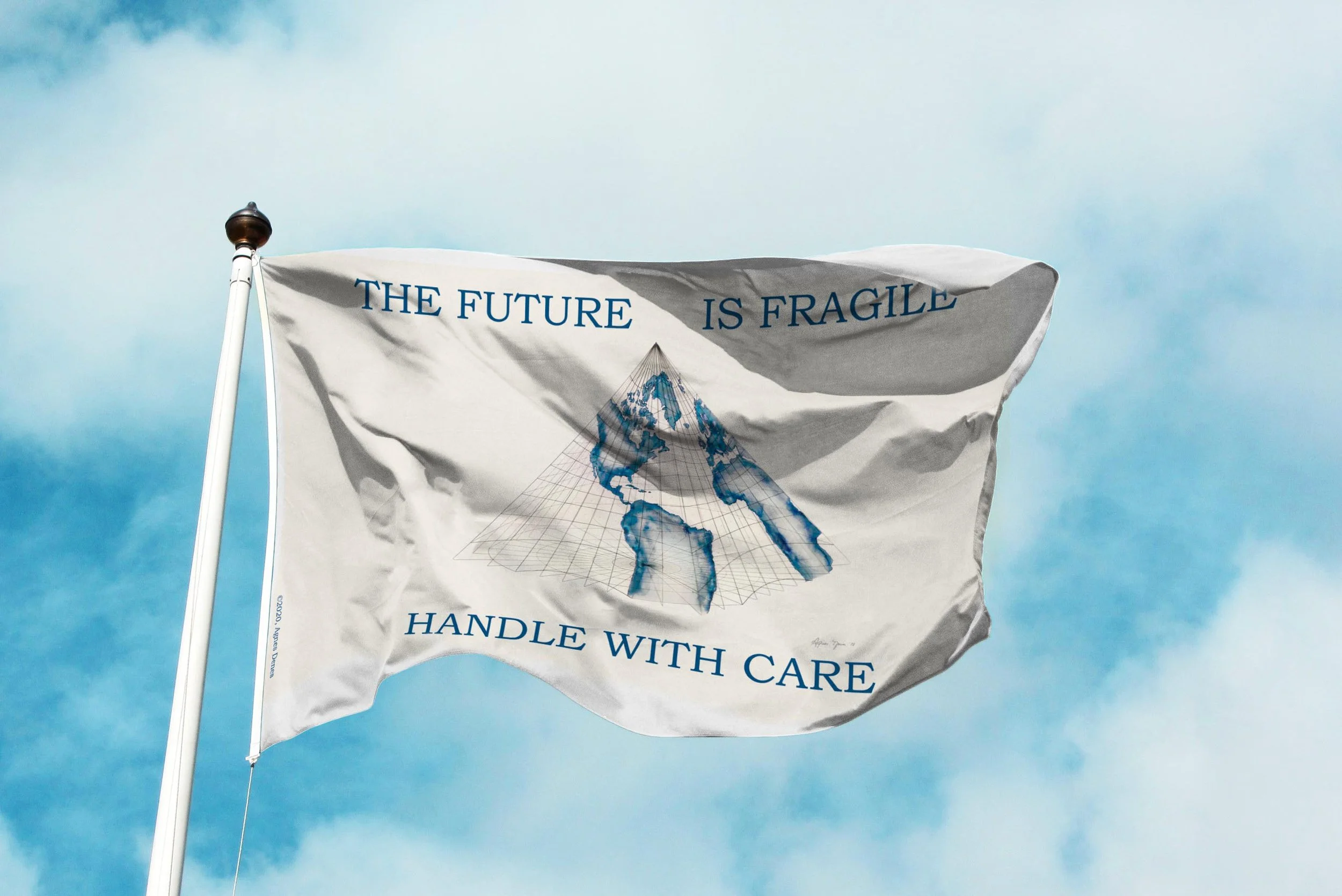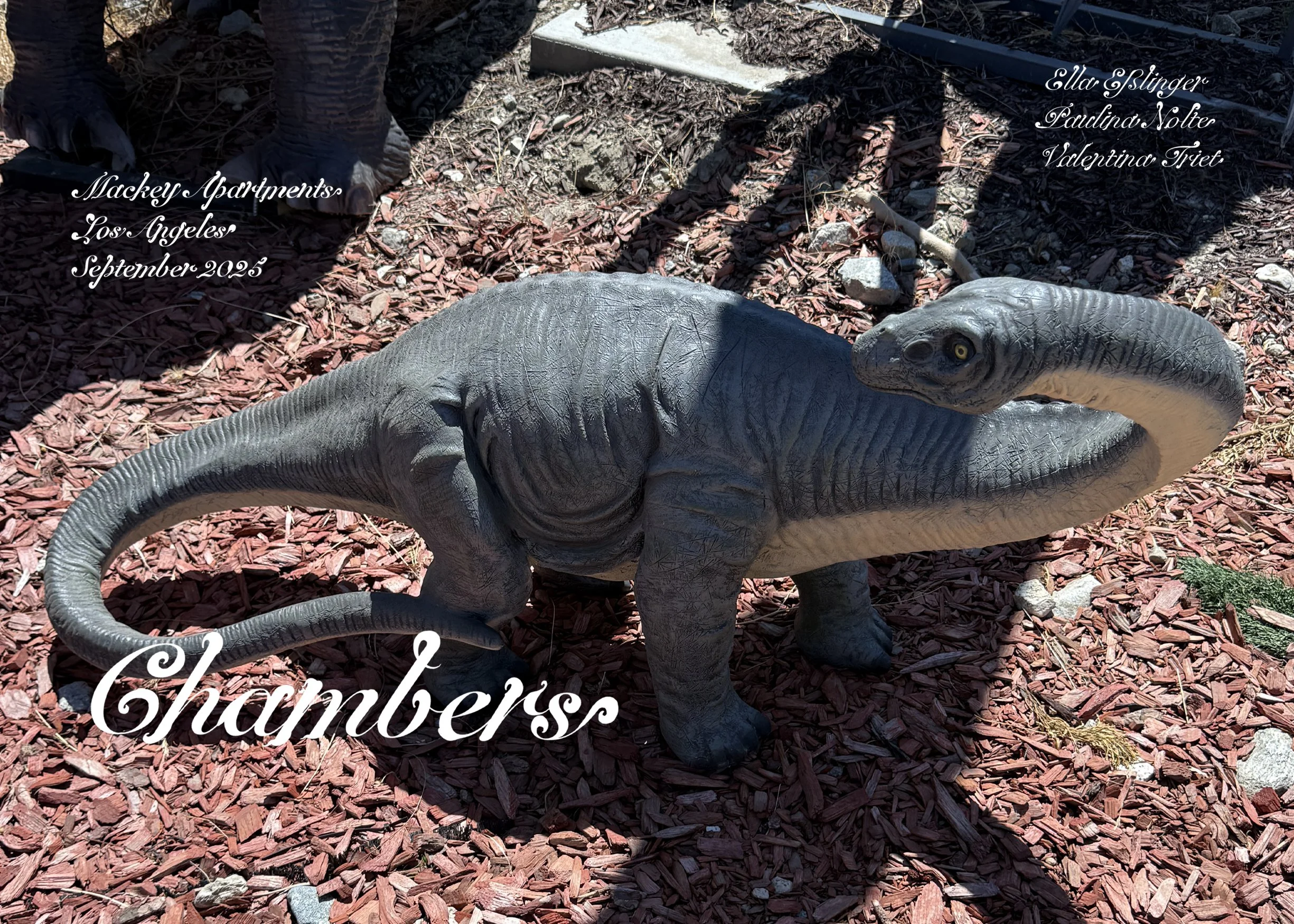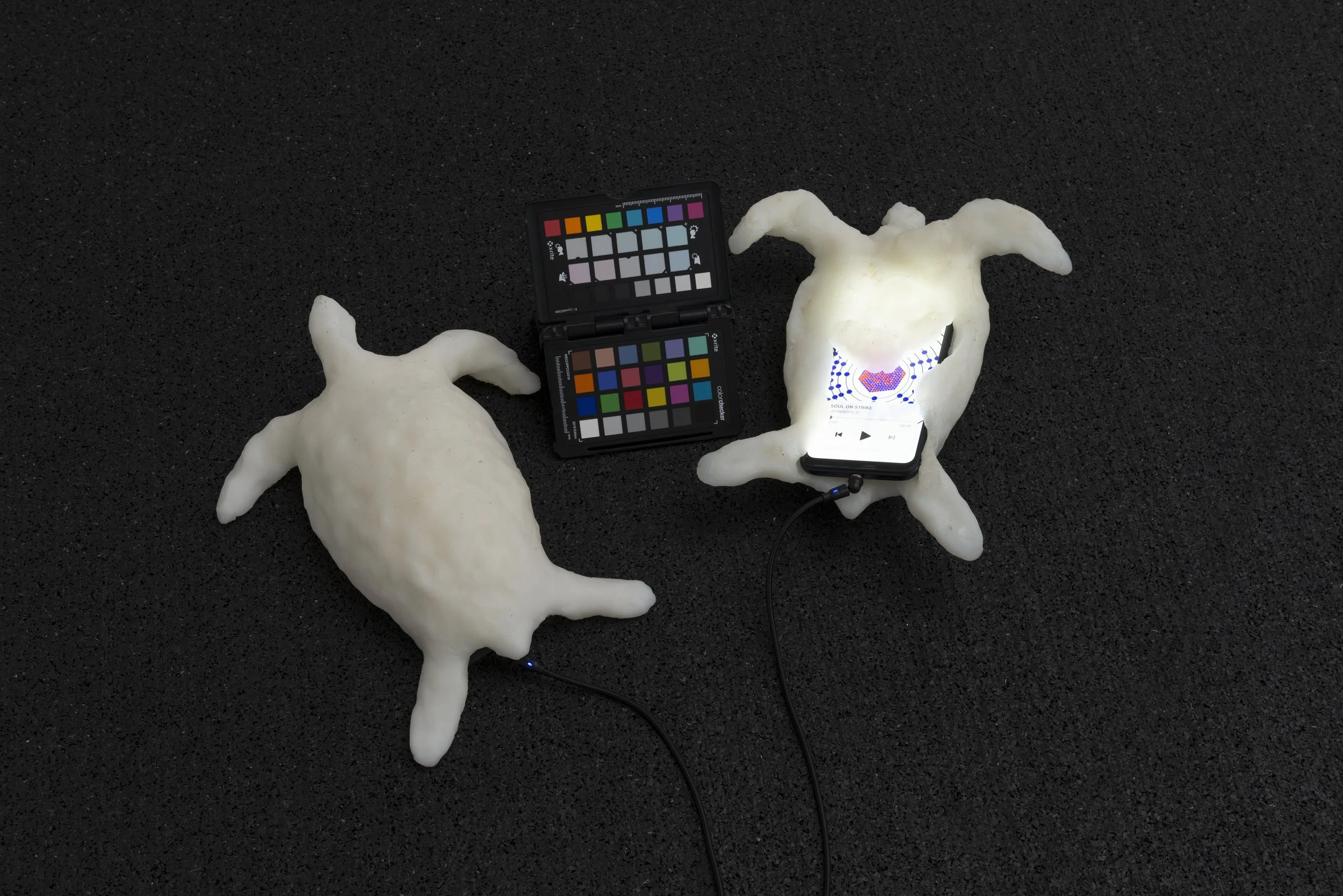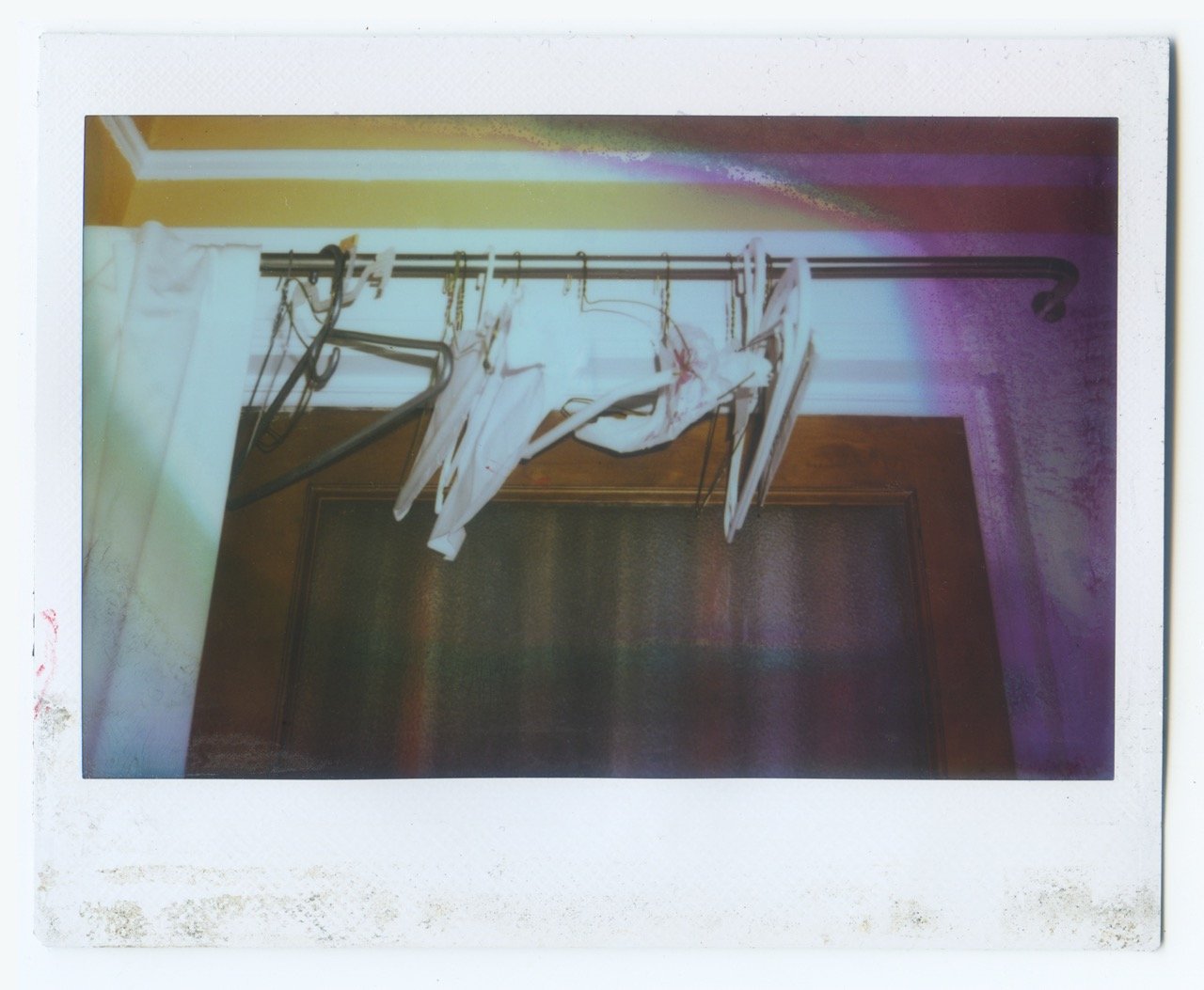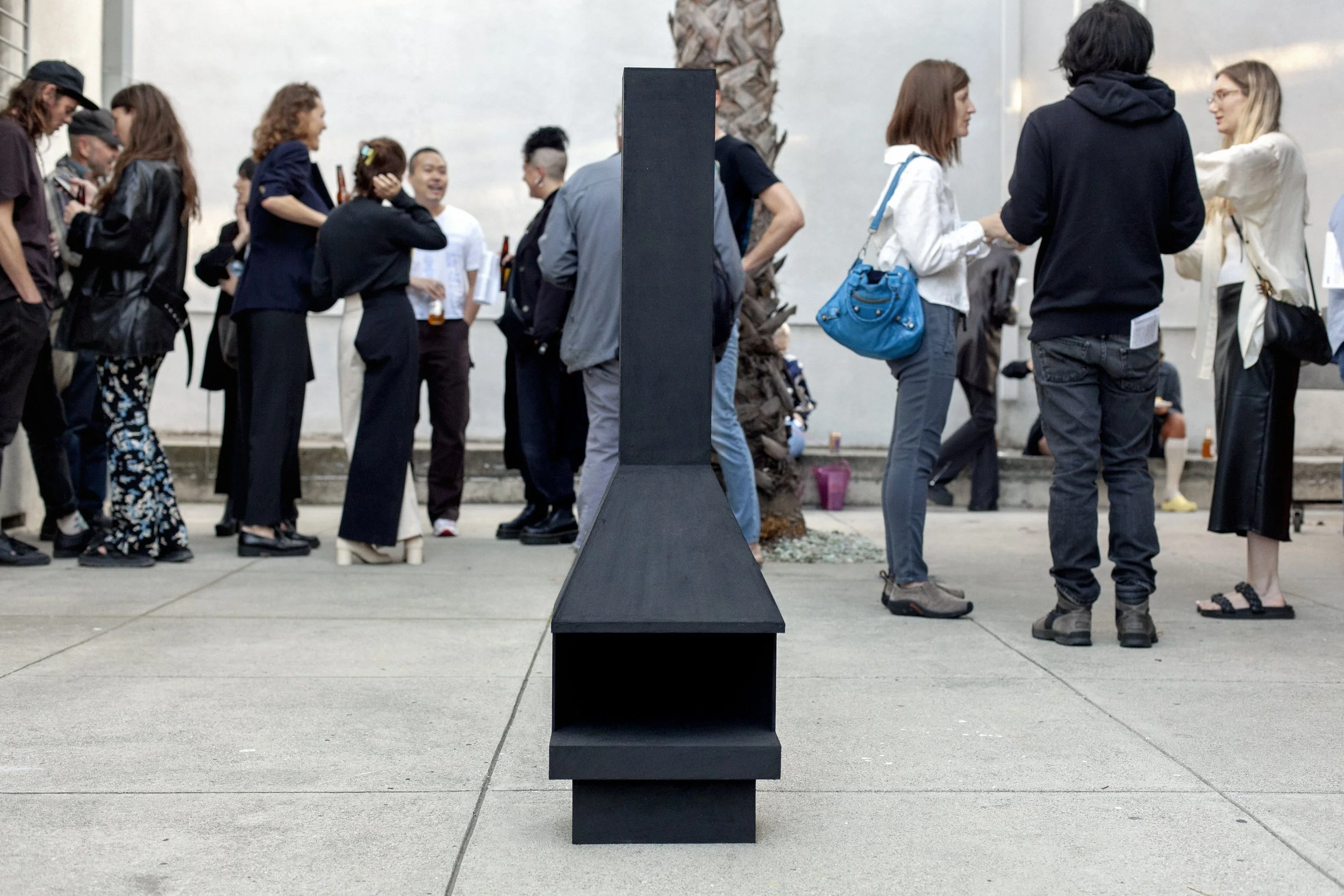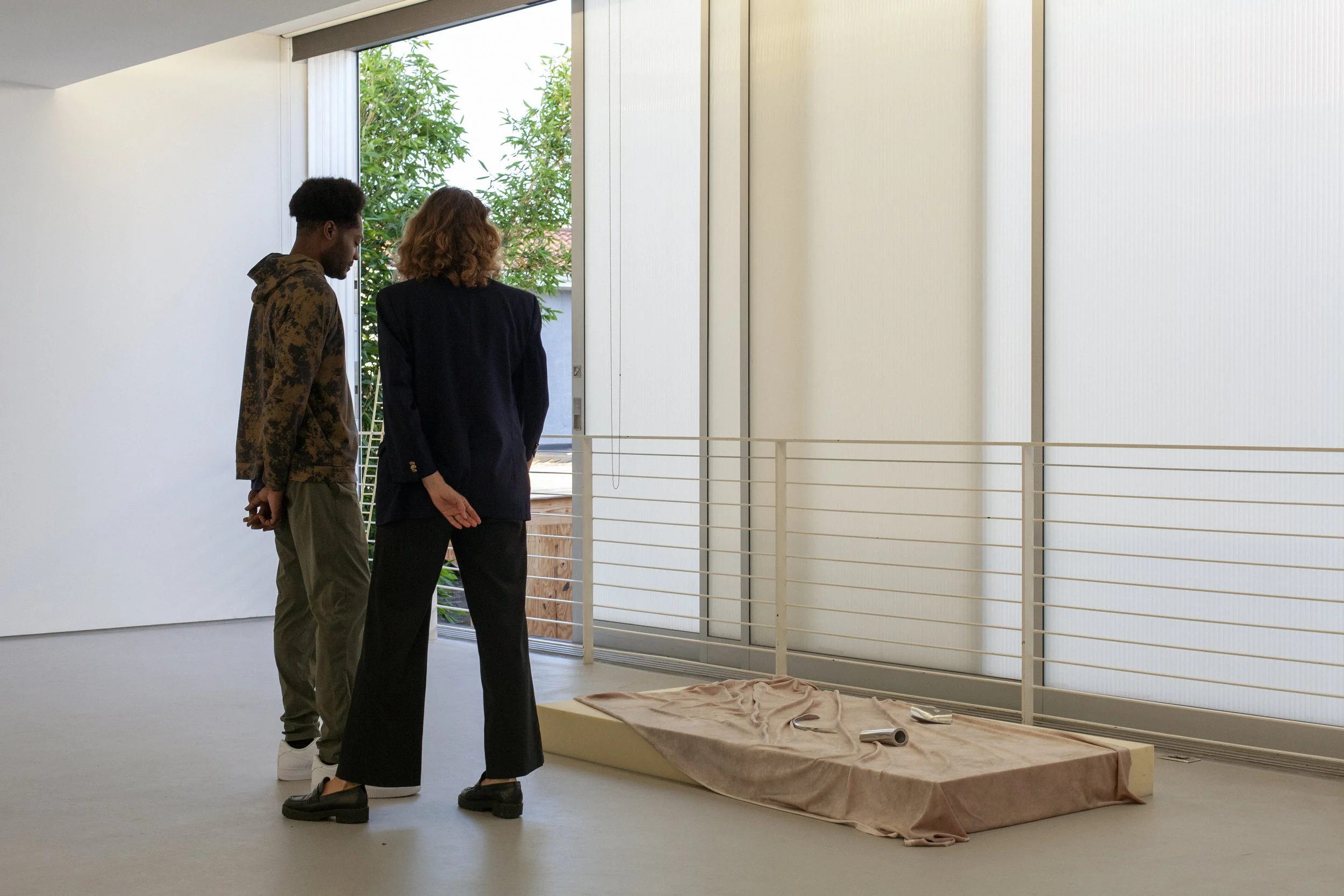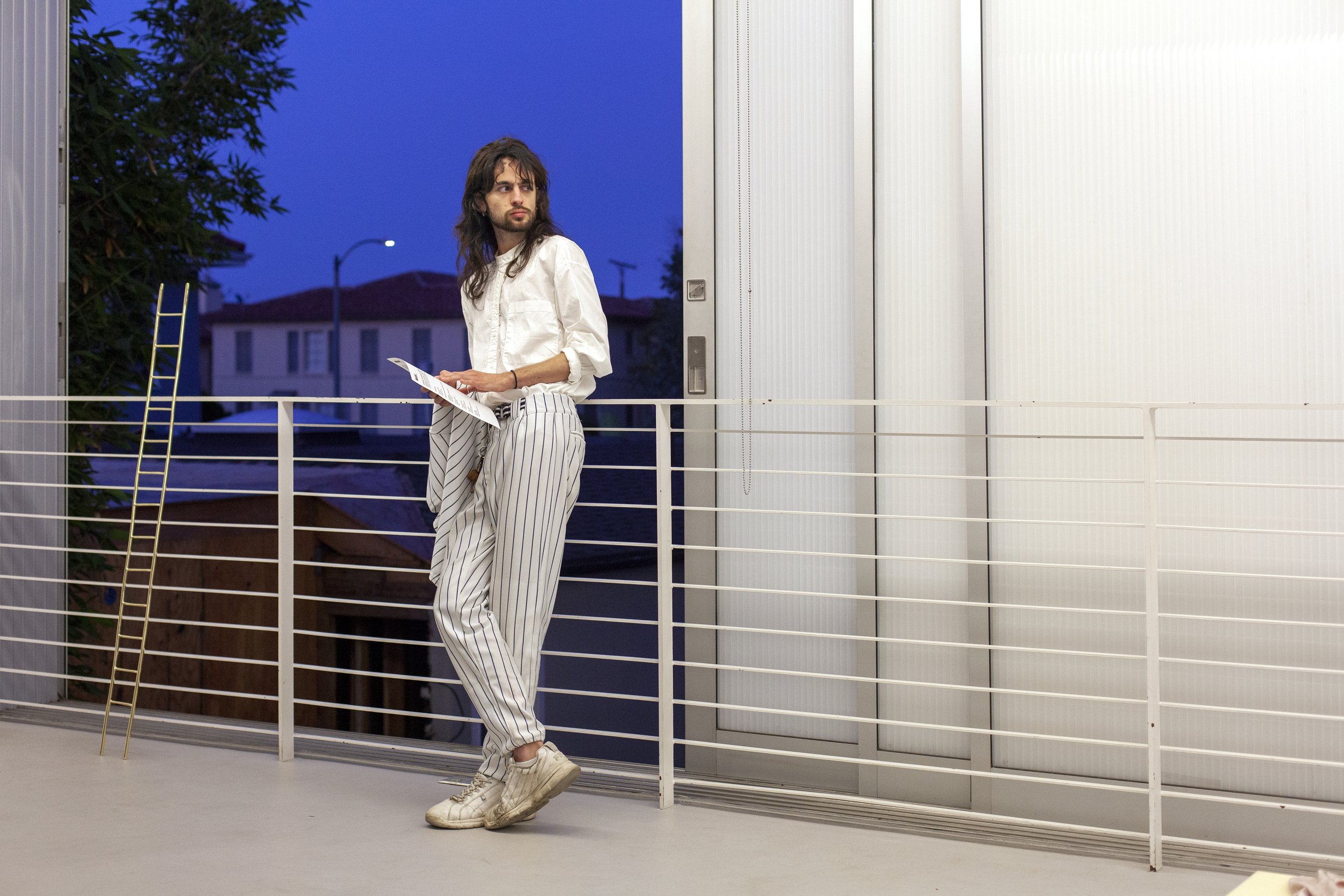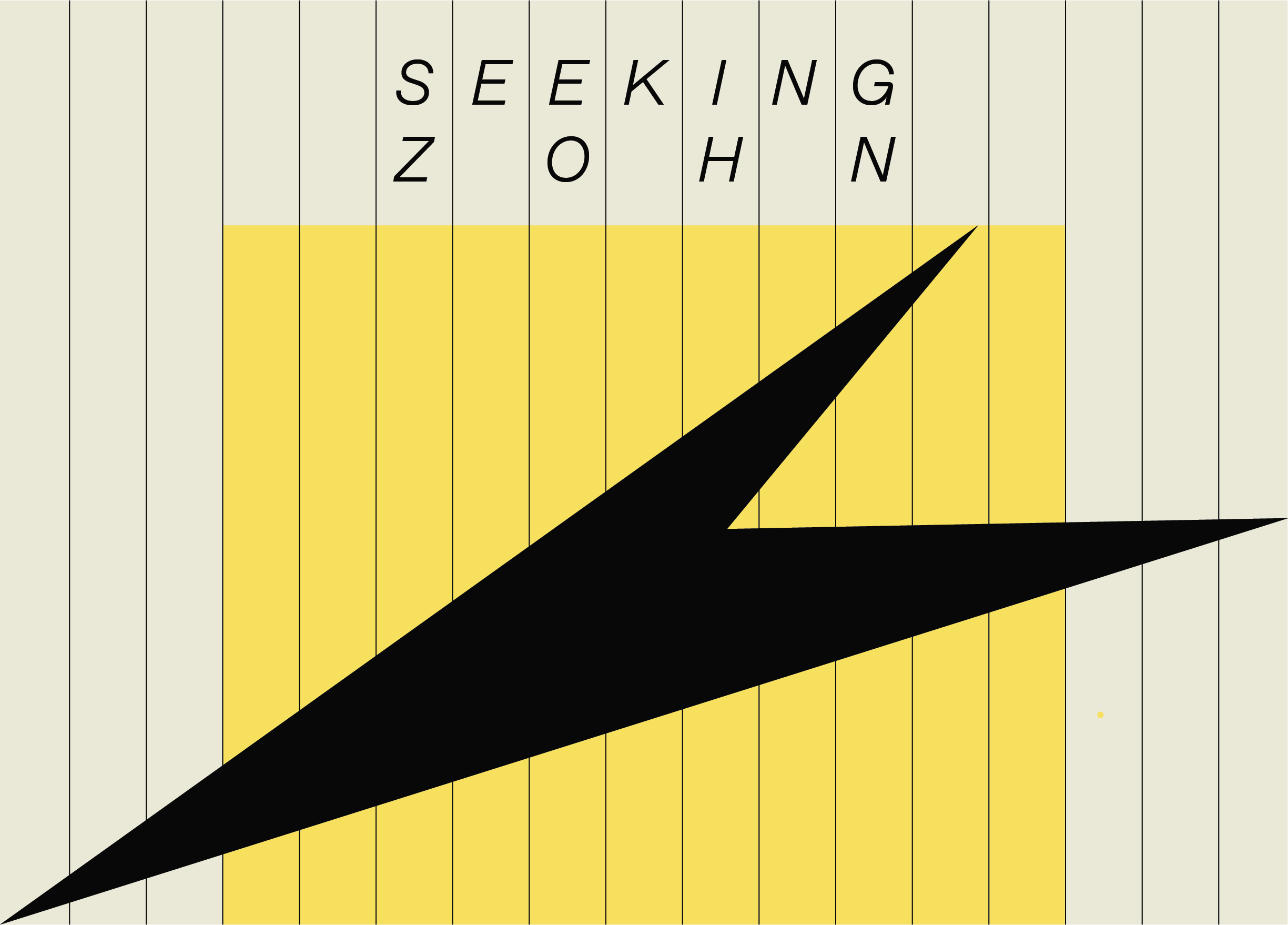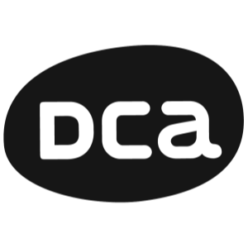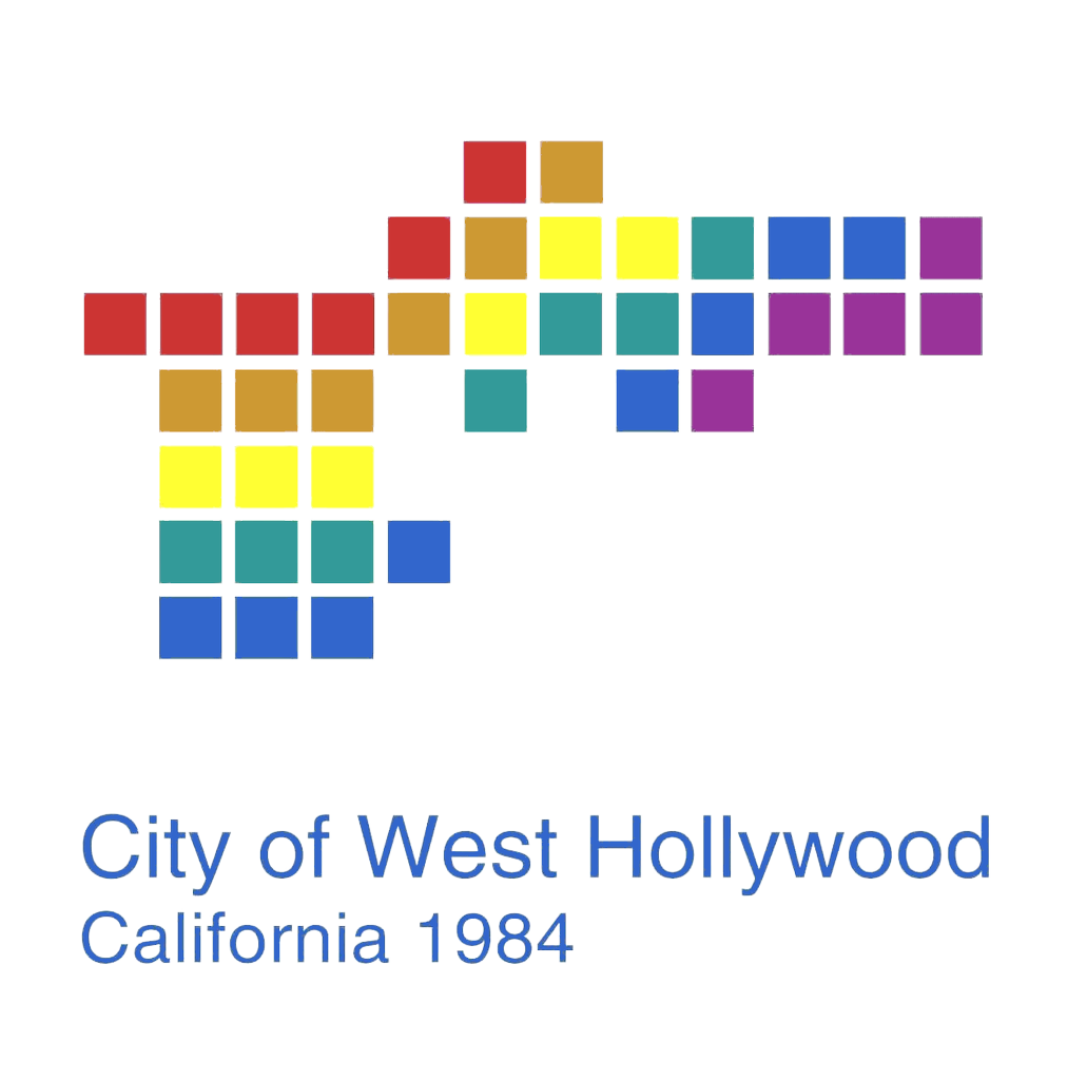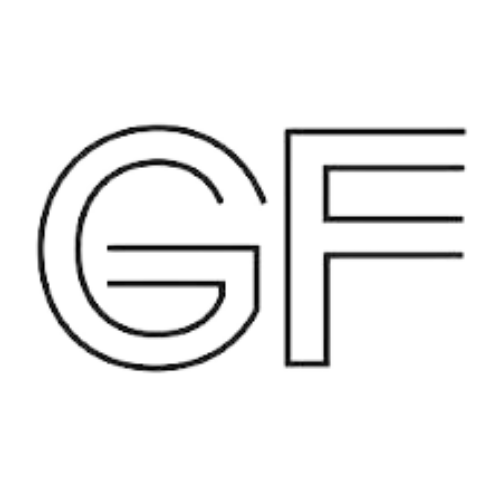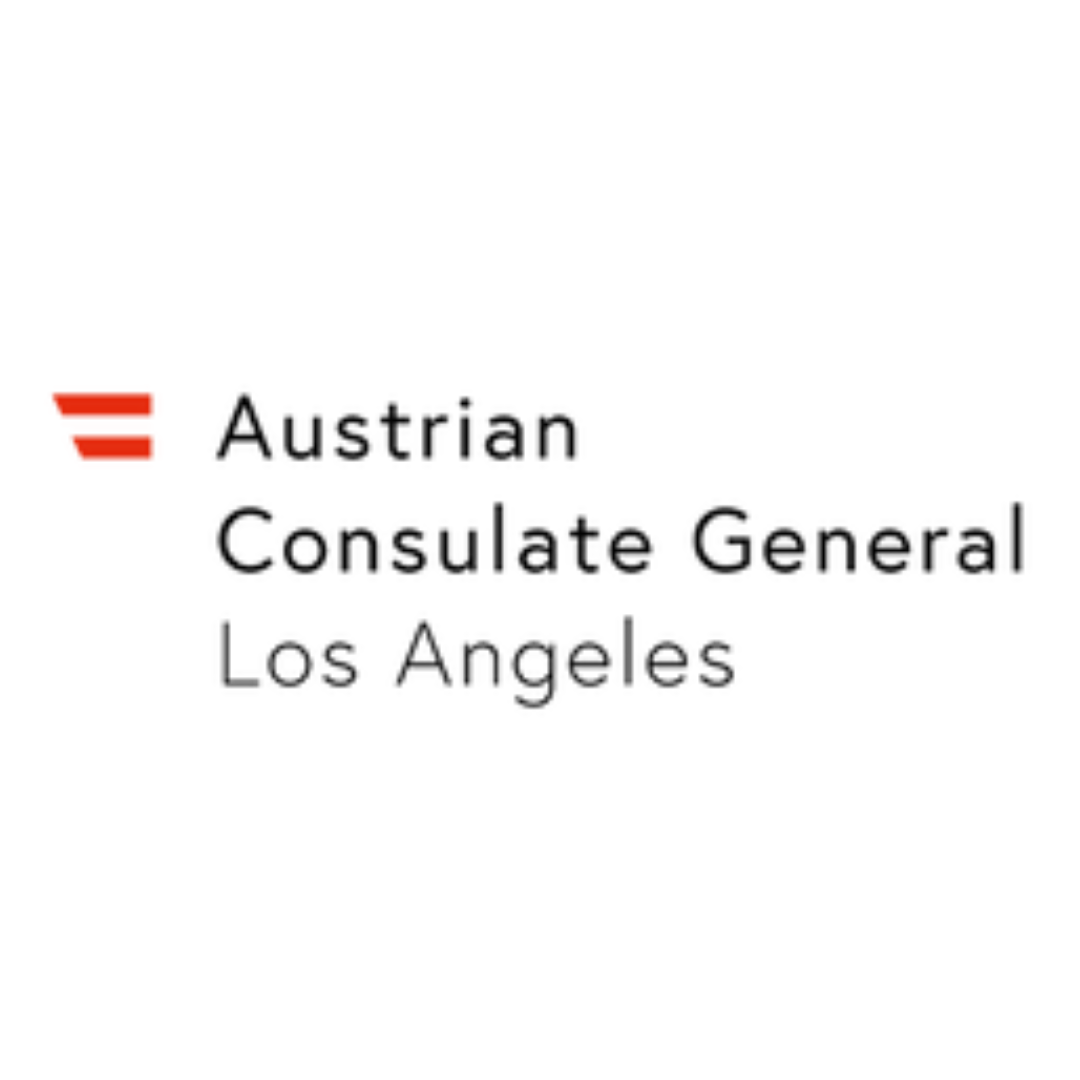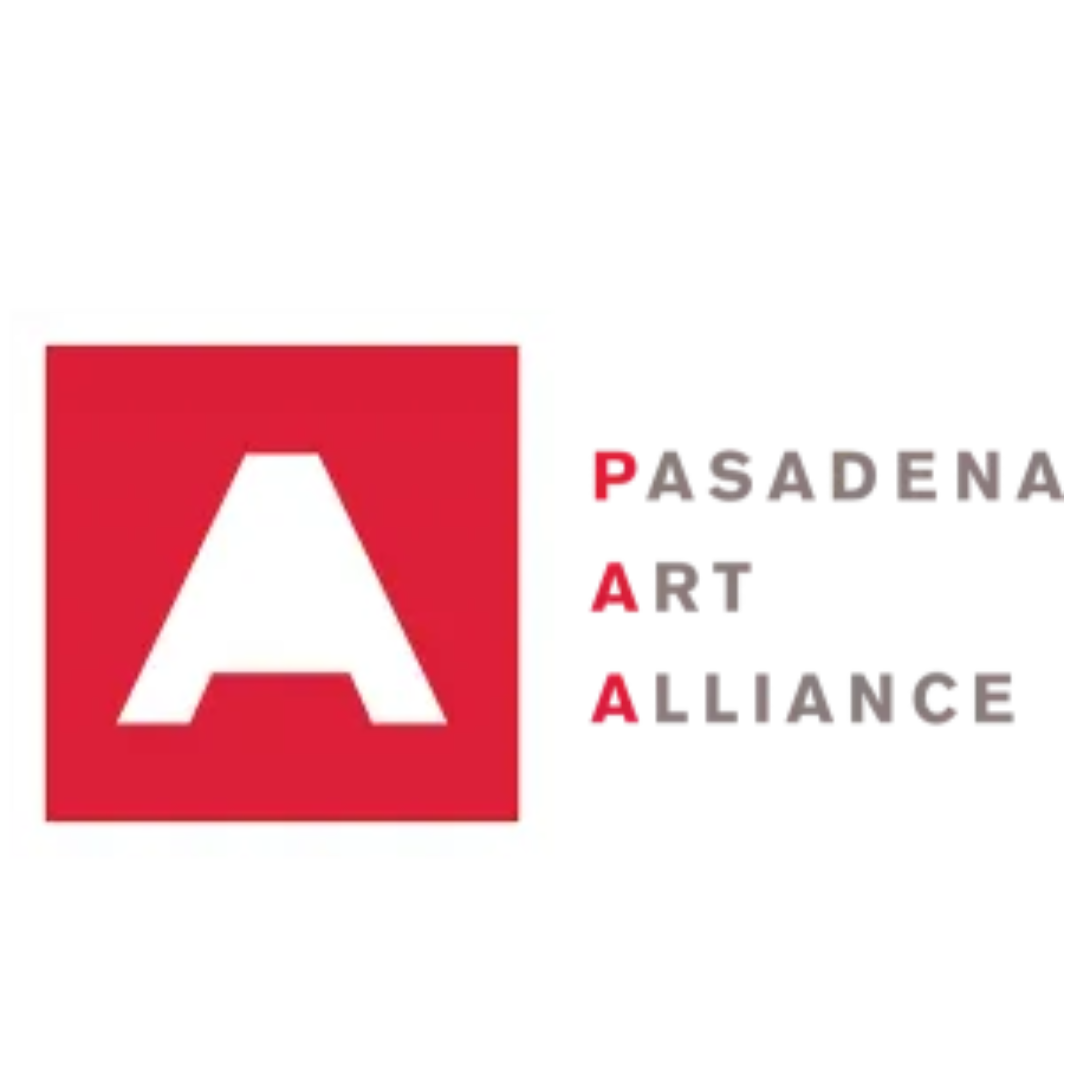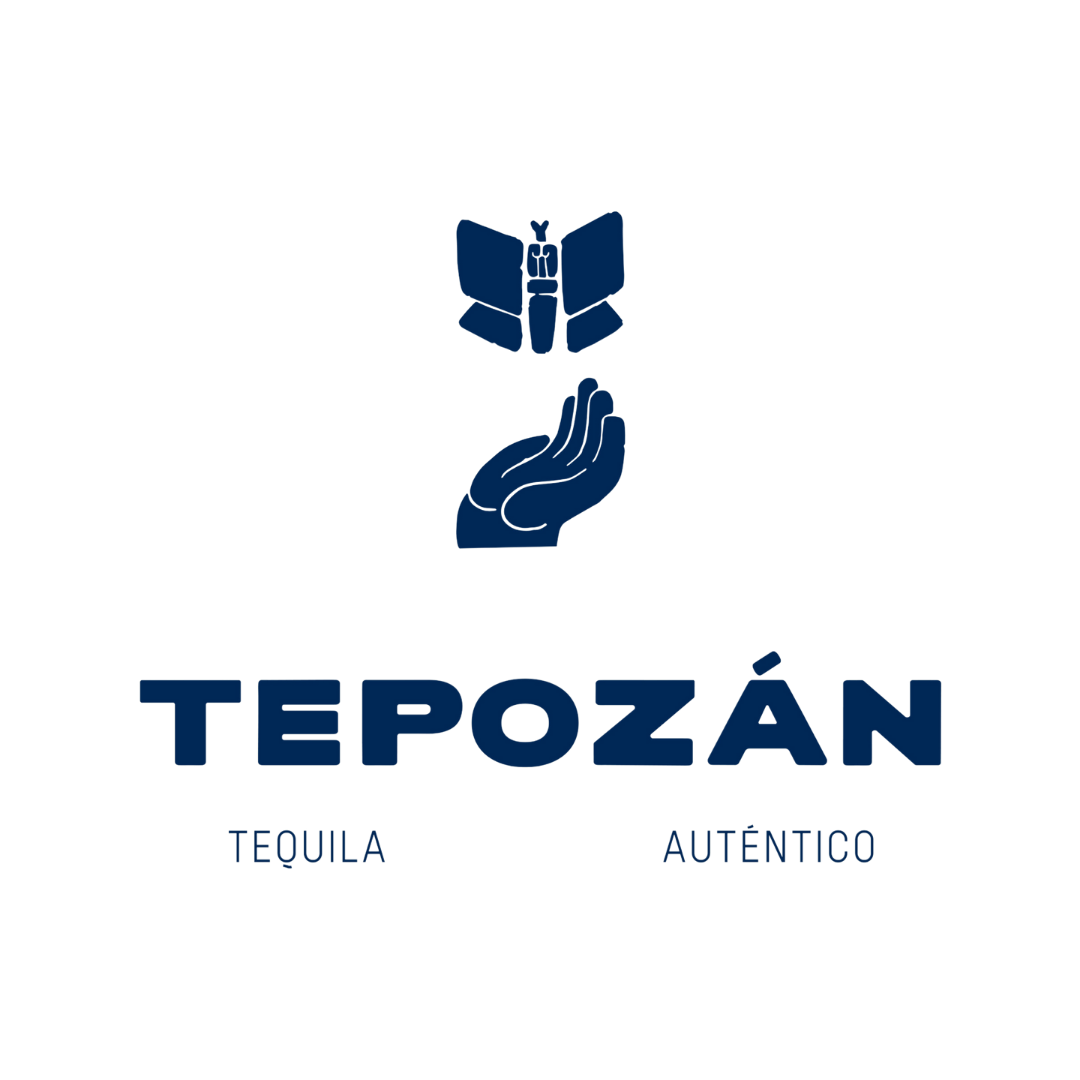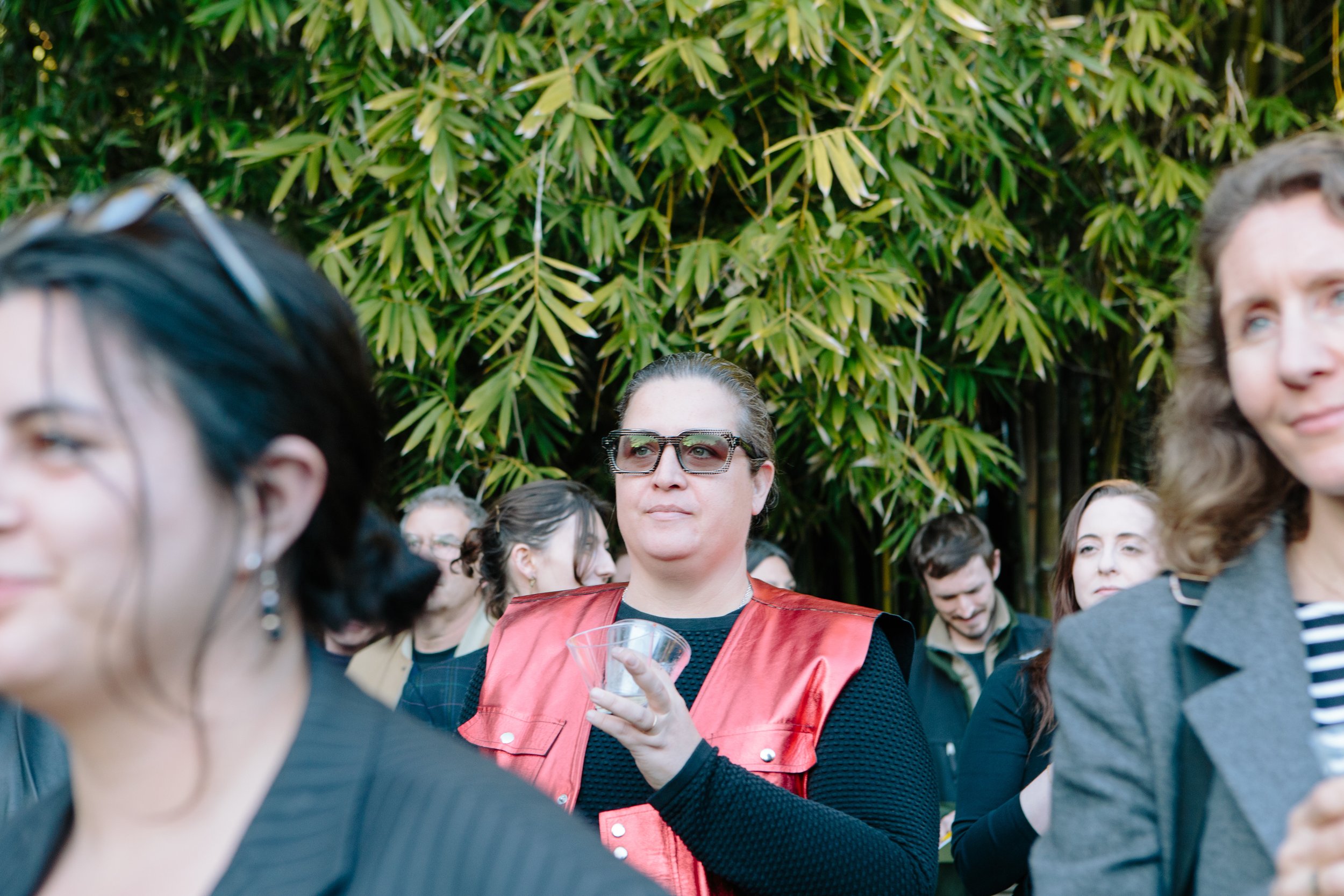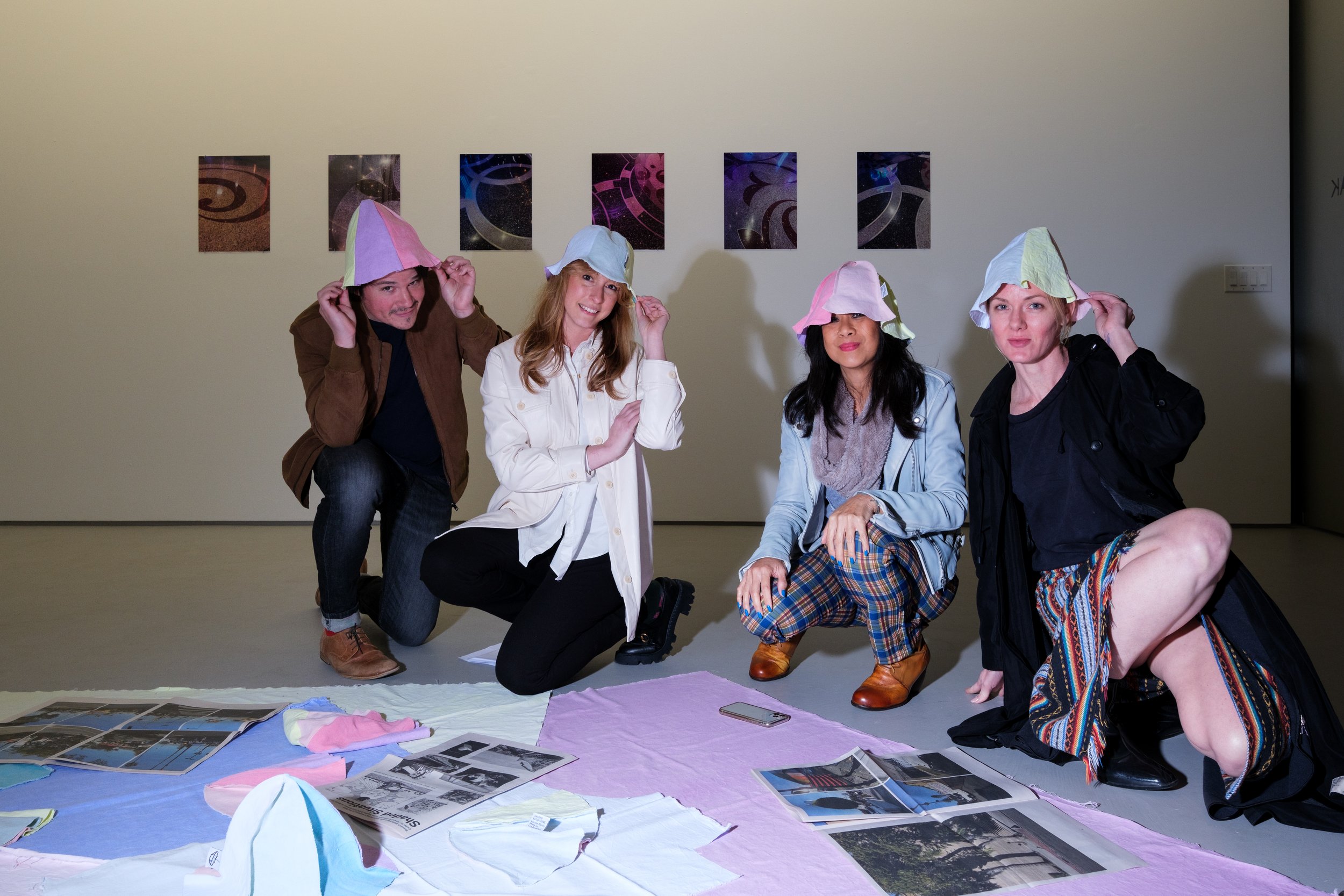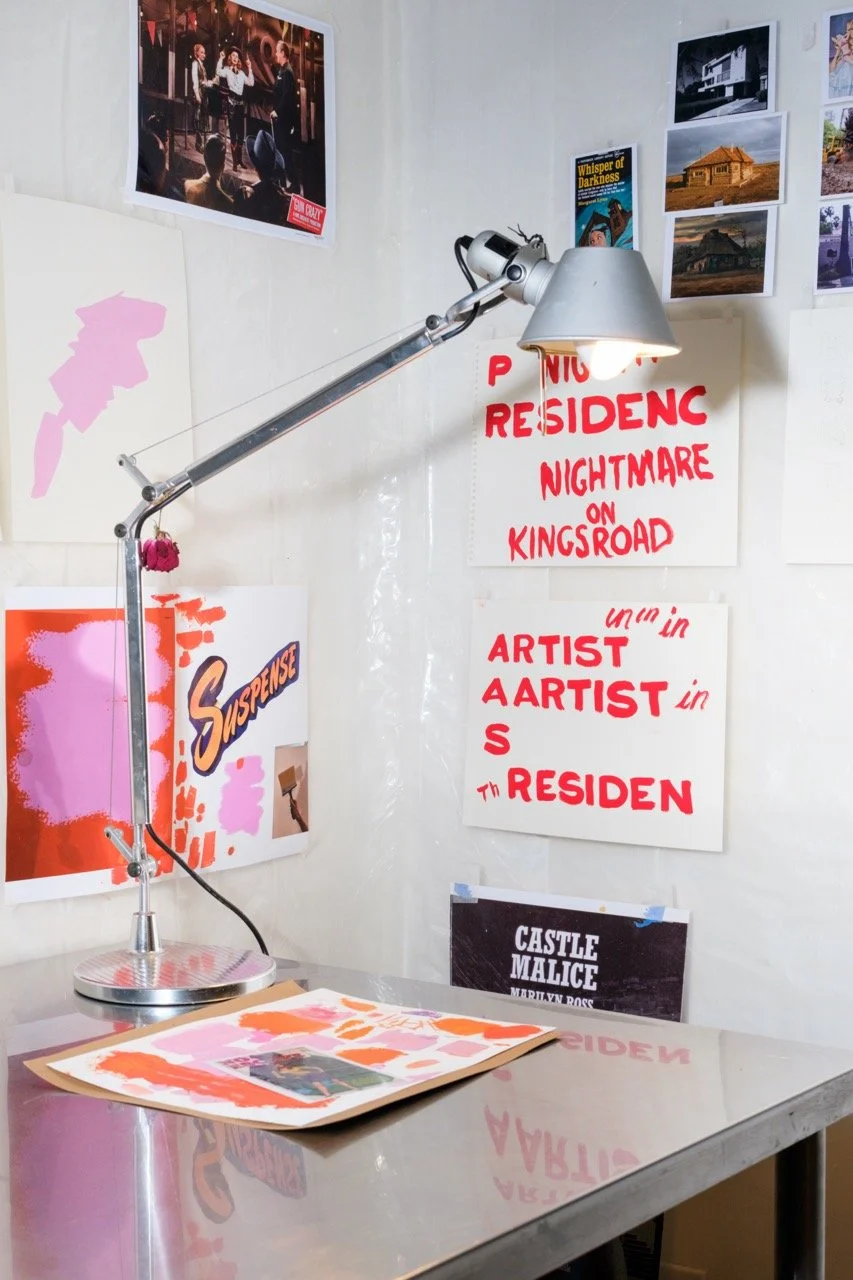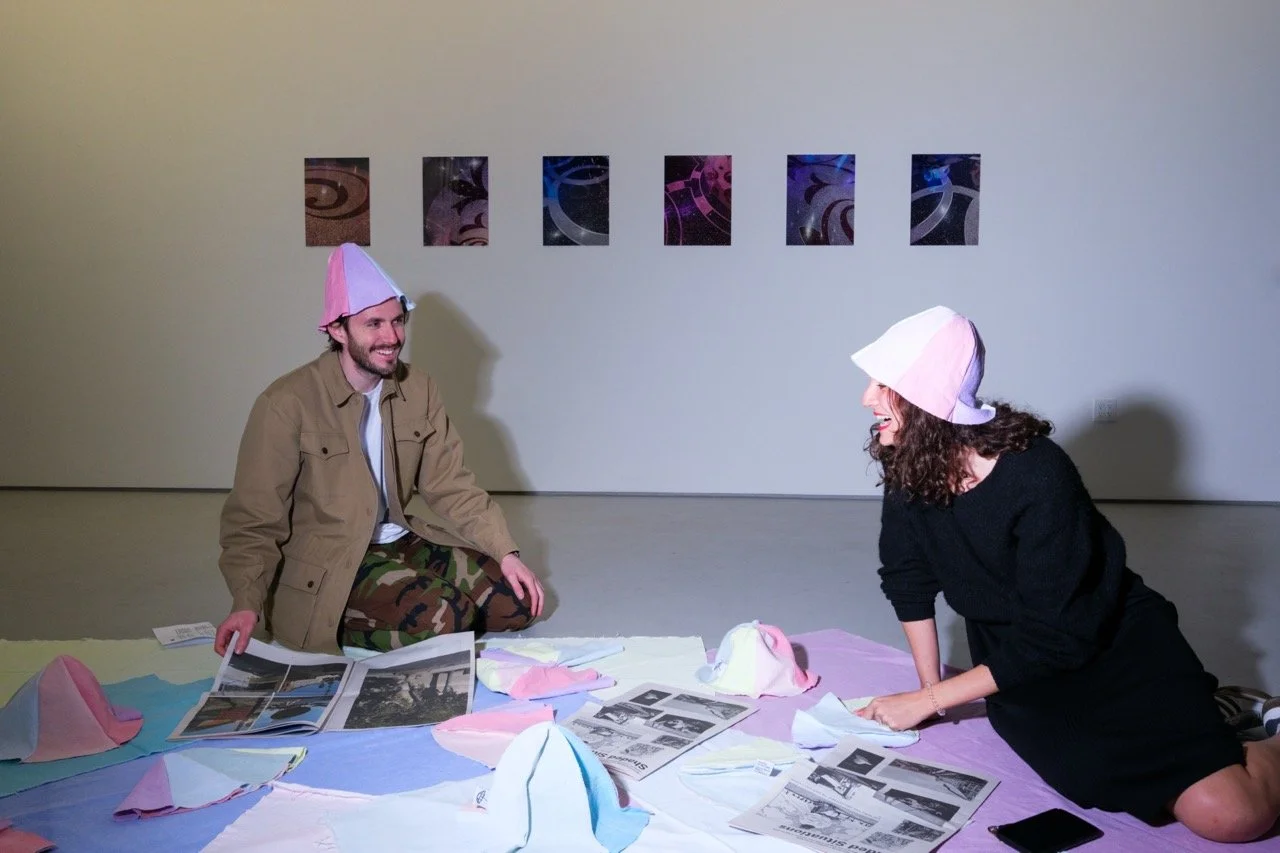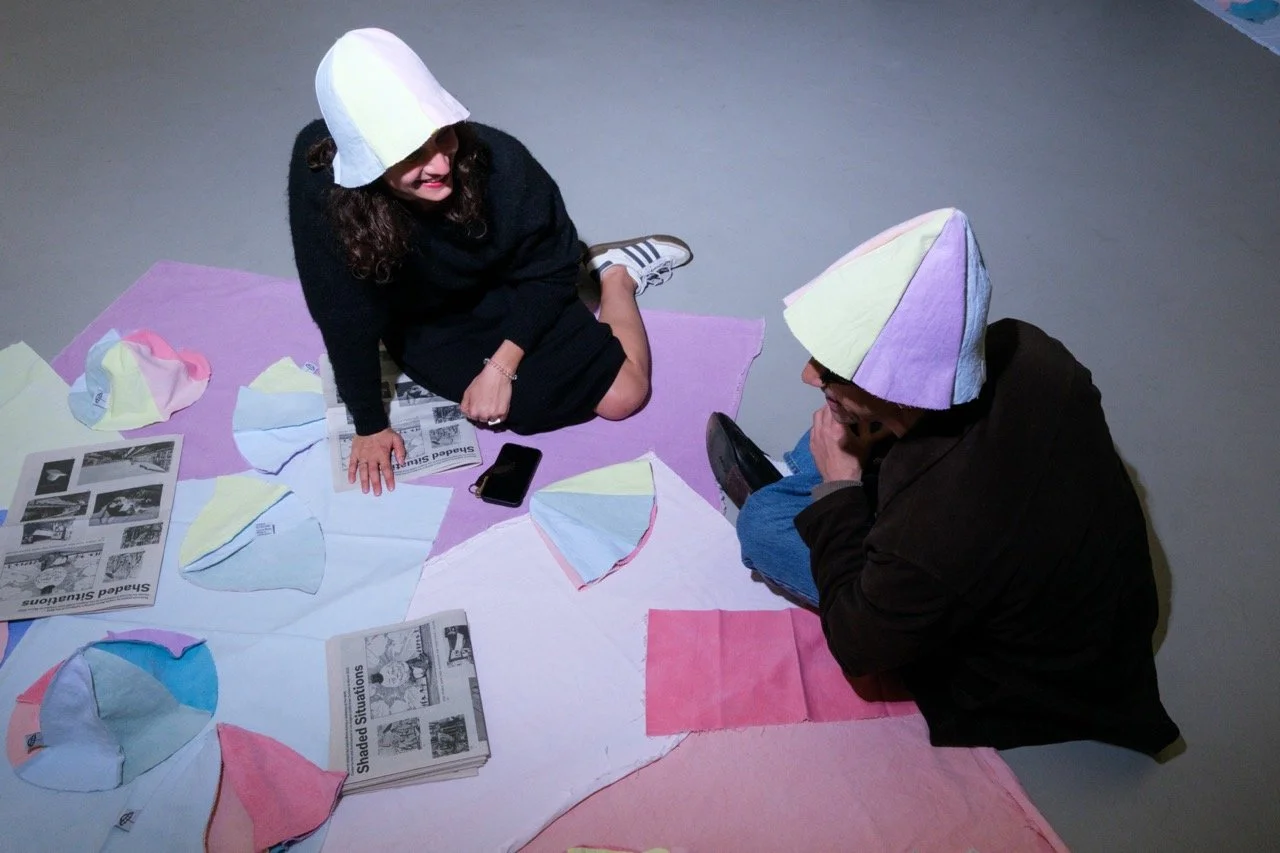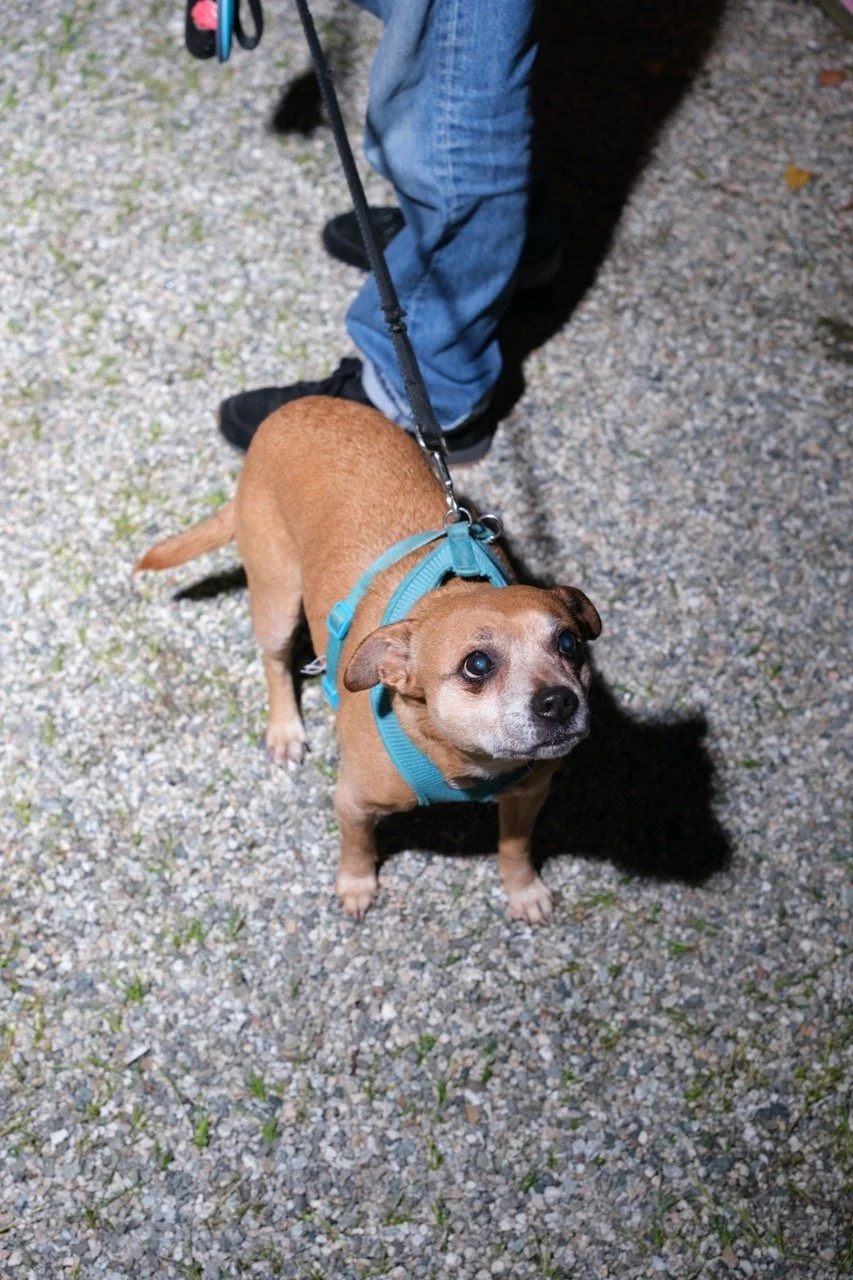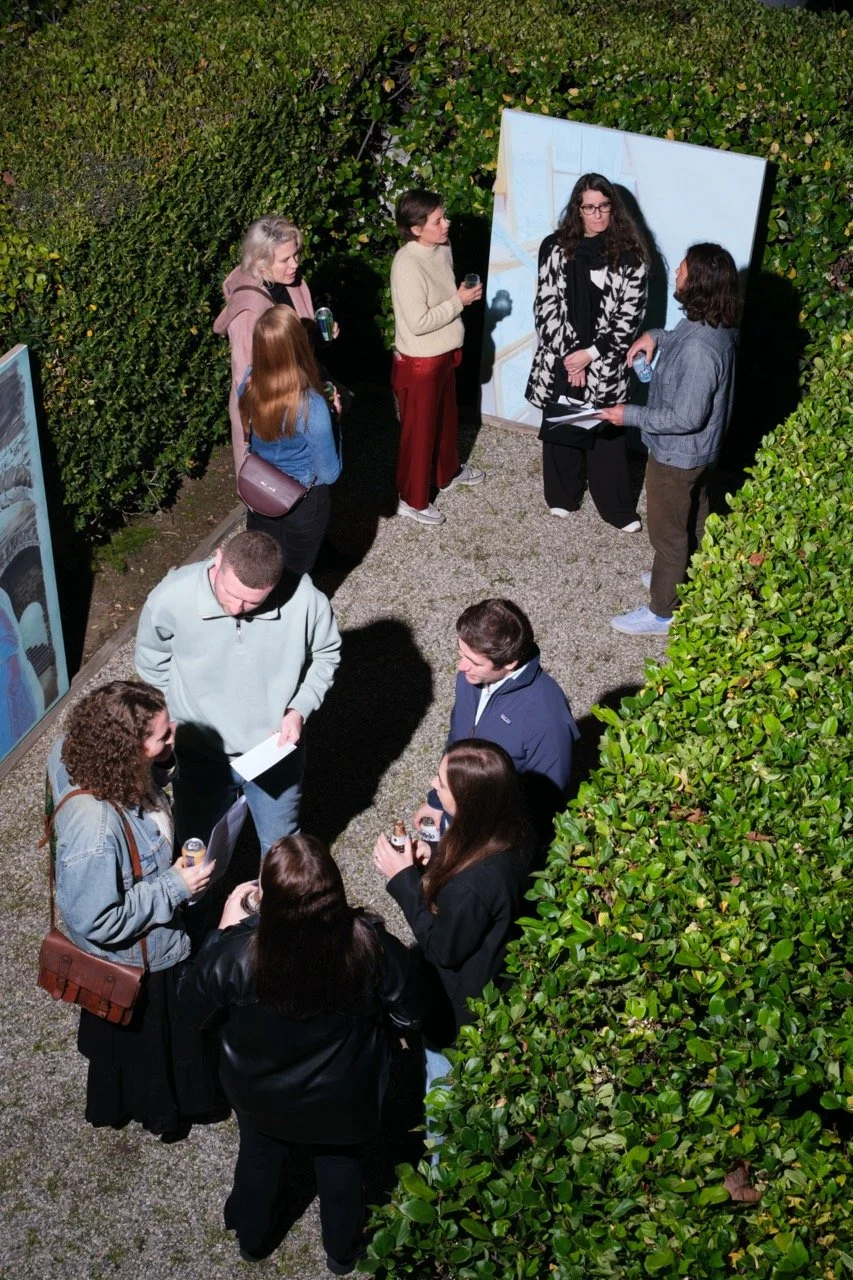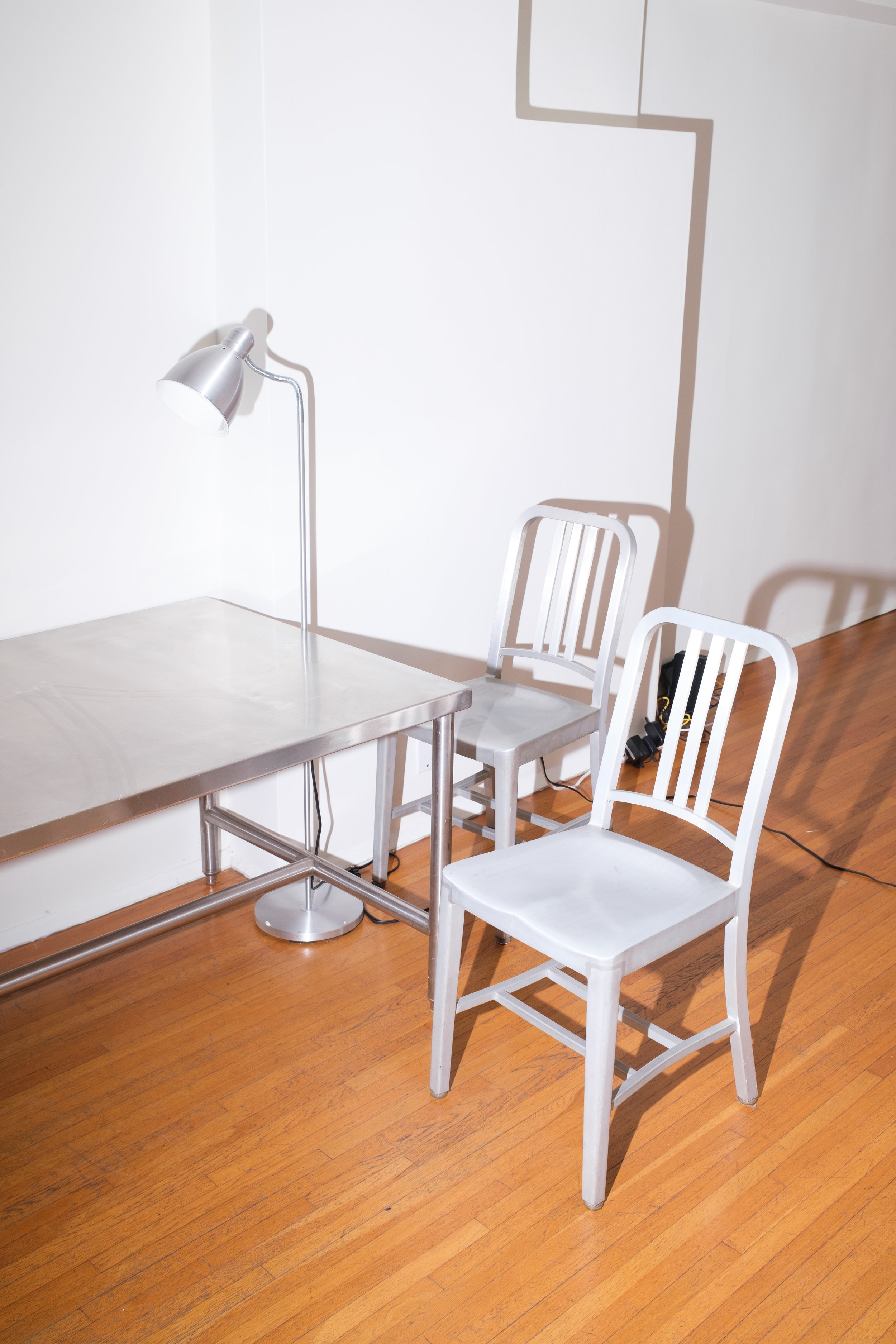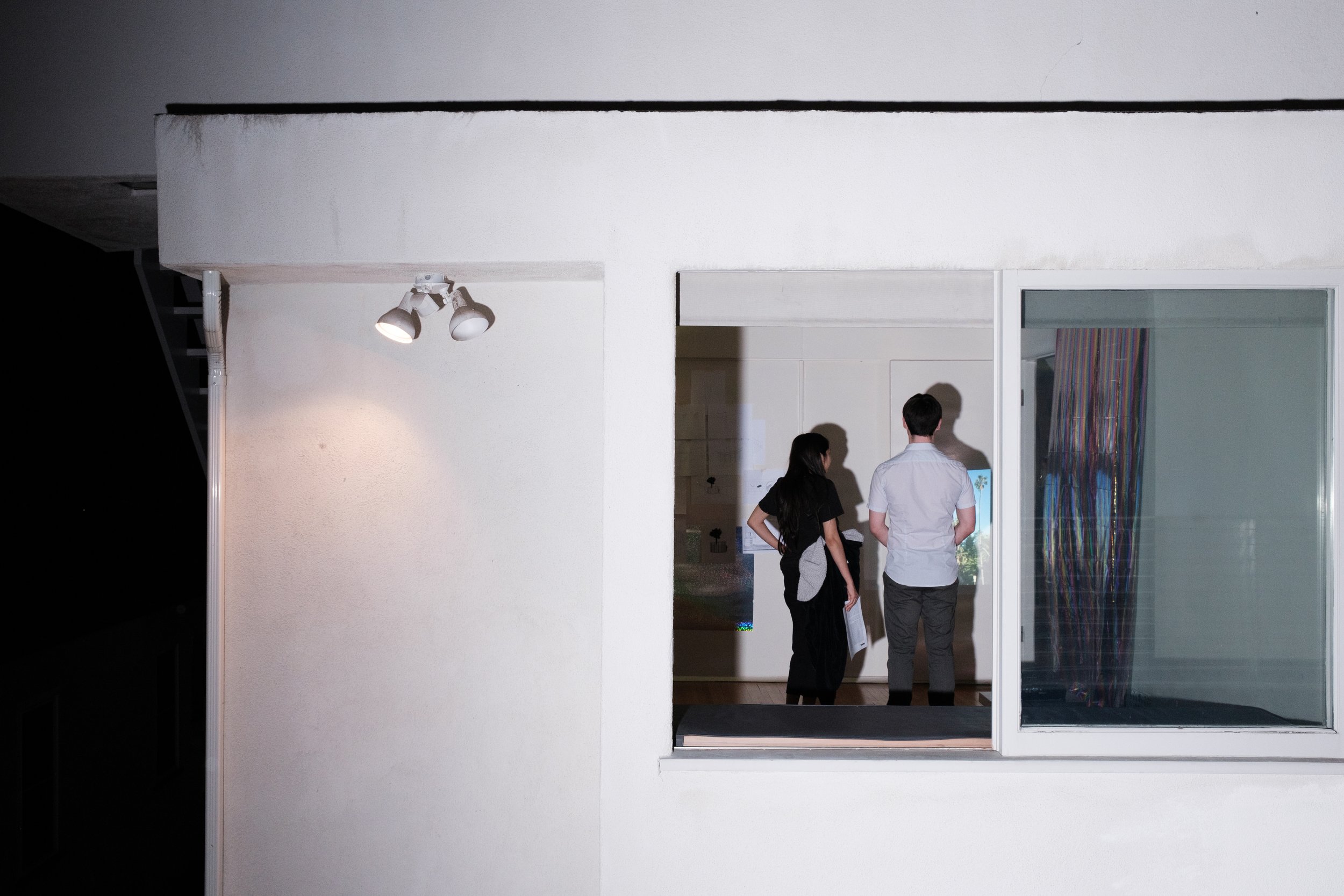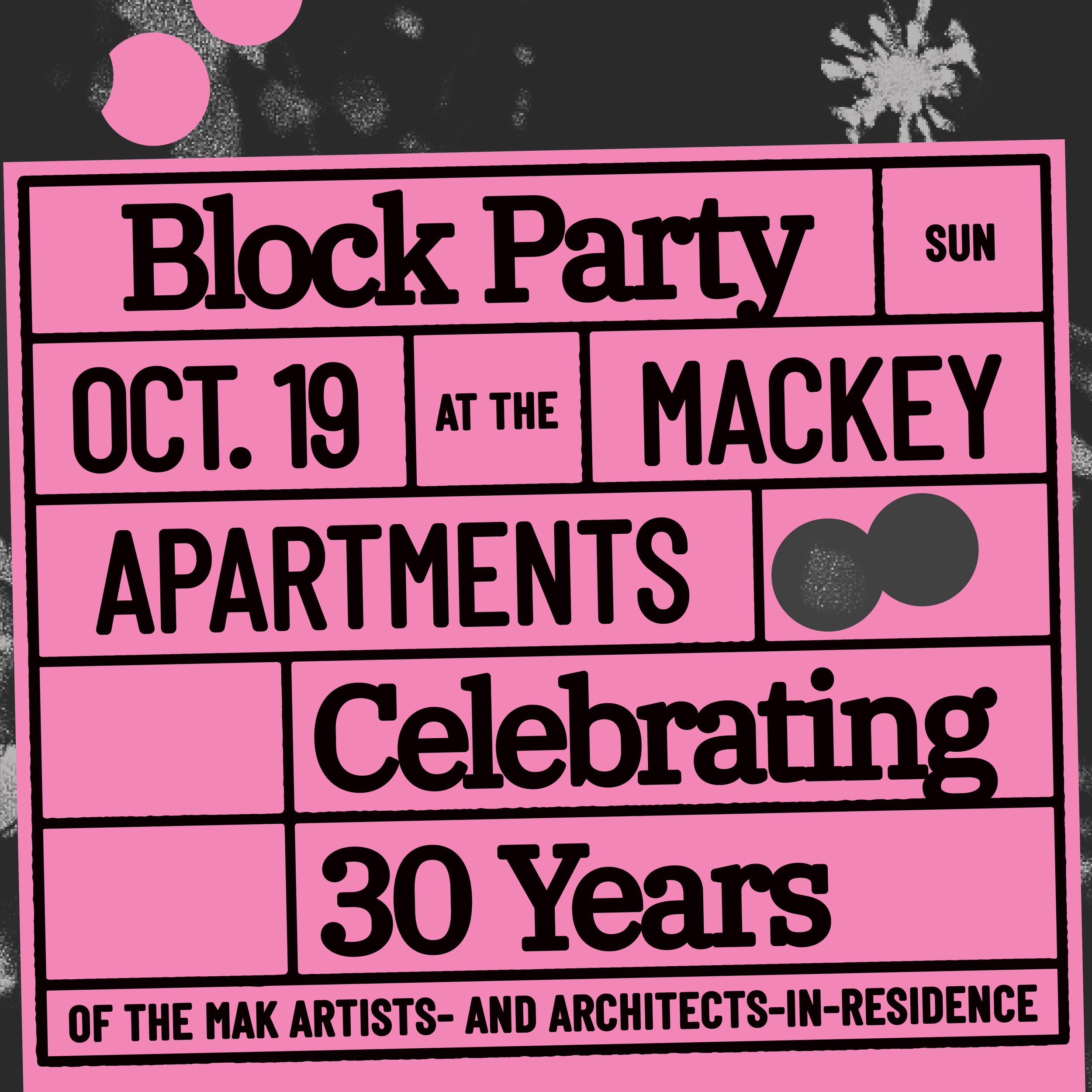
MAK Artists- and Architects-in-Residence 30th Anniversary Block Party
The 30th Anniversary Block Party celebrates three decades of the MAK Artists- and Architects-in-Residence program at the Mackey Apartments, which has served as a haven for international artists and architects to research, produce, and become immersed in the culture of Los Angeles.
The MAK Artists- and Architects-in-Residence Program was inaugurated in October 1995 with the arrival of its first cohort of artists and architects. Initiated earlier that year, an international jury has since convened annually in Vienna to select up to eight residency projects as well as two alternates per group. To date, the MAK Center has hosted more than fifty groups of international residents. This unique program is funded by the Federal Ministry for Arts, Culture, the Civil Service and Sport, in cooperation with the MAK — Museum of Applied Arts, Vienna.
The Block Party will mark the launch of the MAK Center’s new Alumni Archive Module, bring together Los Angeles-based Residency Alumni, and features the opening of the 26th iteration of Garage Exchange, showcasing Vienna-based artist and Mackey Residency alumnus Christoph Meier alongside Los Angeles-based artist Chadwick Rantanen. Guests are also invited to tour the Mackey Apartments and connect with friends, alumni, and MAK Center supporters over food, drinks, and conversation. Together, these elements create a multifaceted celebration of the MAK Artists- and Architects-in-Residence Program’s thirty-year legacy of creative exchange.
3:00 PM Residency Alumni Panel with Simona Ferrari, Julia Koerner, Christoph Meier, and Luis Ortega Govela, moderated by Anthony Carfello
4:00 PM Walkthrough of Garage Exchange with Christoph Meier and Chadwick Rantanen
Reception and Block Party to Follow
Panelists
ANTHONY CARFELLO
Anthony Carfello is a curator, editor, and educator.
He is the Museum Manager/Curator of the Venice Heritage Museum, an initiative to preserve the stories of L.A.'s changing beachside community. From 2020 to 2022, Carfello served as Deputy Director of the Wende Museum in Culver City. For the decade prior (2009–19), he was Deputy Director of the MAK Center for Art and Architecture at the Schindler House. Since 2017 he has taught as an adjunct assistant professor for Temple University’s L.A. study program, and from 2022 to 2024 he taught the art history of L.A. for Elon University (NC). Currently, he is a Visiting Assistant Professor of Museum Studies at the University of Iowa.
He has received support from the Andy Warhol Foundation Arts Writers Grant for the online journal Georgia (with Shoghig Halajian and Suzy Halajian) and the Graham Foundation for Advanced Studies in the Fine Arts.
SIMONA FERRARI
Simona Ferrari is an architect working across different scales and formats. Practicing both independently and collaboratively, her work addresses architecture and the built environment through building, photography, drawing, and writing. Simona studied architecture at the Politecnico di Milano and the Technical University of Vienna, and received her Master’s degree from the Tokyo Institute of Technology. She completed a Master of Fine Arts at the Zurich University of the Arts. Alongside her practice, between 2017-2023, Simona taught and conducted research at the Department of Architecture at ETH Zurich and was assistant curator of the Japan Pavilion at the 16th Venice Architecture Biennale (2018). Previously, she worked with Atelier Bow-Wow in Tokyo, completing several international projects, including the Search Library in Muharraq, Bahrain, exhibition designs and installations at the Cultural Center of Chicago, Harvard GSD, the National Museum of Modern Art in Tokyo, the MAXXI Museum in Rome, and the Triennale di Milano. Recent works include “Landscape In-Between,” a project for the former industrial site of Acetati in Verbania, Italy, awarded in the 15th edition of the Europan architectural competition and subsequently developed as an urban plan commissioned by the municipality, involving the local community. Simona was an architect-in-residence at the MAK Center for Art and Architecture in Los Angeles and at the Charles Moore Foundation in Santa Monica.
JULIA KOERNER
Julia Koerner is an award-winning Austrian designer working at the convergence of architecture, product and fashion design, specialized in 3D-printing. She is the founder of JK Design GmbH /JK3D and a professor at UCLA. Her recent collaborations include 3D-Printed Haute Couture and costumes for Marvel’s Hollywood blockbuster ‘Black Panther’ earning two Academy Awards. Furthermore, she has developed research on innovative uses of 3D printing with Swarovski, Stratasys, and Materialise. She is internationally recognized for design innovation in 3D printing and recently was awarded for her architectural design for ICON's 3d-printed affordable housing Initiative 99. JK3D is a next generation brand that focuses on 3D-printed fashion and décor products. The brand features iconic nature-inspired designs, with intricate and complex designs that can only be made through innovative 3D printing technology, utilizing sustainable plant-based materials. JK3D is a woman-owned business with design ateliers and urban manufacturing facilities in Vienna and Los Angeles. Since 2024 she serves on the Creative Industries Council of the Federal Ministry of Labour and Economy of Austria as part of the "Innovation Program for the Creative Industries 2030.
CHRISTOPH MEIER
Christoph Meier (b. 1980, Vienna) studied architecture at the Vienna University of Technology and sculpture at the Academy of Fine Arts Vienna and Glasgow School of Art. His internationally exhibited, installation-based work often engages with architectural and social spaces. Meier has participated in numerous exhibitions, including at the Museum of Applied Arts Vienna, Wiener Festwochen, Portland Institute of Art, Etablissement d’en face Brussels, and the Nam June Paik Art Center Seoul. He has presented solo exhibitions at venues such as Casino Luxembourg, Kiosk Gent, Kunstverein Hamburg, Kunsthaus Graz, and the Vienna Secession. Since 2009, Meier has co-published the artist fanzine BLACK PAGES with Ute Müller and Nick Oberthaler and, in 2016, co-founded the independent exhibition space Guimarães in Vienna. From 2019 to 2020, he was professor at the Institute of Art and Design at the Vienna University of Technology, where he now works as a senior artist at the Research Unit for Three-Dimensional Design and Model Making. Recently Meier has realized Gills Bells, a large-scale carillon as a public artwork in Gilsdorf, Luxembourg.
LUIS ORTEGA GOVELA
Luis Ortega Govela (1988) is a Mexican architect, writer and filmmaker based in Los Angeles. He graduated from the Architectural Association School of Architecture London. He is the founder of Office LOG, a research-based design studio working across architecture, design and art. . He is theco-founder of ÅYR, an art collective which explores the complex evolution of the home and domesticity. The collective has exhibited internationally, including at theBritish Pavilion for the Venice Architecture Biennale and at the 9th Berlin Biennale of Contemporary Art.
He is the author of GARAGE a book on the architecture and image of the garage published by MIT Press which has now been translated into Russian by Strelka. The book was also adapted into a documentary and was part of the CPH:DOX festival official selection. He was a recipient of the MAK Center for Art and Architecture Residency in 2017. He has lectured at the Architectural Association London, TU Delft, Garage Museum Moscow and The Royal College of Art. He is currently working on his third book.
Garage Exchange Artists
CHRISTOPH MEIER
Christoph Meier (b. 1980, Vienna) studied architecture at the Vienna University of Technology and sculpture at the Academy of Fine Arts Vienna and Glasgow School of Art. His internationally exhibited, installation-based work often engages with architectural and social spaces. Meier has participated in numerous exhibitions, including at the Museum of Applied Arts Vienna, Wiener Festwochen, Portland Institute of Art, Etablissement d’en face Brussels, and the Nam June Paik Art Center Seoul. He has presented solo exhibitions at venues such as Casino Luxembourg, Kiosk Gent, Kunstverein Hamburg, Kunsthaus Graz, and the Vienna Secession. Since 2009, Meier has co-published the artist fanzine BLACK PAGES with Ute Müller and Nick Oberthaler and, in 2016, co-founded the independent exhibition space Guimarães in Vienna. From 2019 to 2020, he was professor at the Institute of Art and Design at the Vienna University of Technology, where he now works as a senior artist at the Research Unit for Three-Dimensional Design and Model Making. Recently Meier has realized Gills Bells, a large-scale carillon as a public artwork in Gilsdorf, Luxembourg.
CHADWICK RANTANEN
Chadwick Rantanen (b. 1981, Wausau, WI) appropriates the forms of familiar consumer goods and modifies and re-contextualizes them into sculptural tools. Adapting and conforming to architecture and infrastructure, Rantanen’s sculptures mimic installations or site-specific works, often taking the form of an adaptor, wedging between objects and their sources of power, articulating a web of accommodation, compromise, maintenance and parasitism by slightly detouring energy, but never causing harm. His solo exhibitions include Secession, Vienna, Austria; Museo Pietro Canonica, Rome, Italy; Standard (Oslo), Oslo, Norway; Essex Street, New York, New York; Overduin and Co., Los Angeles, California; Shane Campbell Gallery, Chicago, Illinois, Bel Ami, Los Angeles, California; CAPITAL, San Francisco, California.

Opening Reception for Agnes Denes: The Future is Fragile
The MAK Center for Art and Architecture is pleased to present Agnes Denes: The Future is Fragile, an exhibition bringing together key works by Agnes Denes that challenge our relationship to land, resources, and ecological stewardship. Known for her pioneering conceptual and environmental art, Denes has long questioned the impact of industrialization and privatization on the natural world, urging us to reimagine land as a shared resource.
RSVP for the opening reception here.
Graphic design support generously provided by Handbuilt
Additional support provided by UAP
Special thanks to Leslie Tonkonow Artworks + Projects
Above Image: The Future is Fragile, Handle With Care (Pyramid) 2021
Copyright Agnes Denes, Courtesy Culturunners and Leslie Tonkonow Artworks + Projects
AGNES DENES: THE FUTURE IS FRAGILE
October 18, 2025 — January 18, 2026
Related Exhibition

Opening Reception for Final Projects: Group LVII - Chambers
Join us for the opening reception of Final Projects: Group LVII - Chambers, exhibiting three bodies of work produced by our Artists and Architects-in-Residence: Ella Eßlinger, Paulina Nolte, and Valentina Triet. Final Projects: Group LVII - Chambers marks the culmination of the 57th iteration of the Artists and Architects-in-Residence Program at the Mackey Apartments.
This event is free and open to the public. Please RSVP here.
Final Projects: Group LVII - Chambers
September 5 — September 7, 2025
Related Exhibition
The Artists & Architects-in-Residence Program at the Mackey Apartments is funded by the Federal Ministry for Arts, Culture, the Civil Service and Sport, in cooperation with the MAK — Museum of Applied Arts, Vienna.
Image courtesy of Ella Eßlinger, Paulina Nolte, and Valentina Triet.
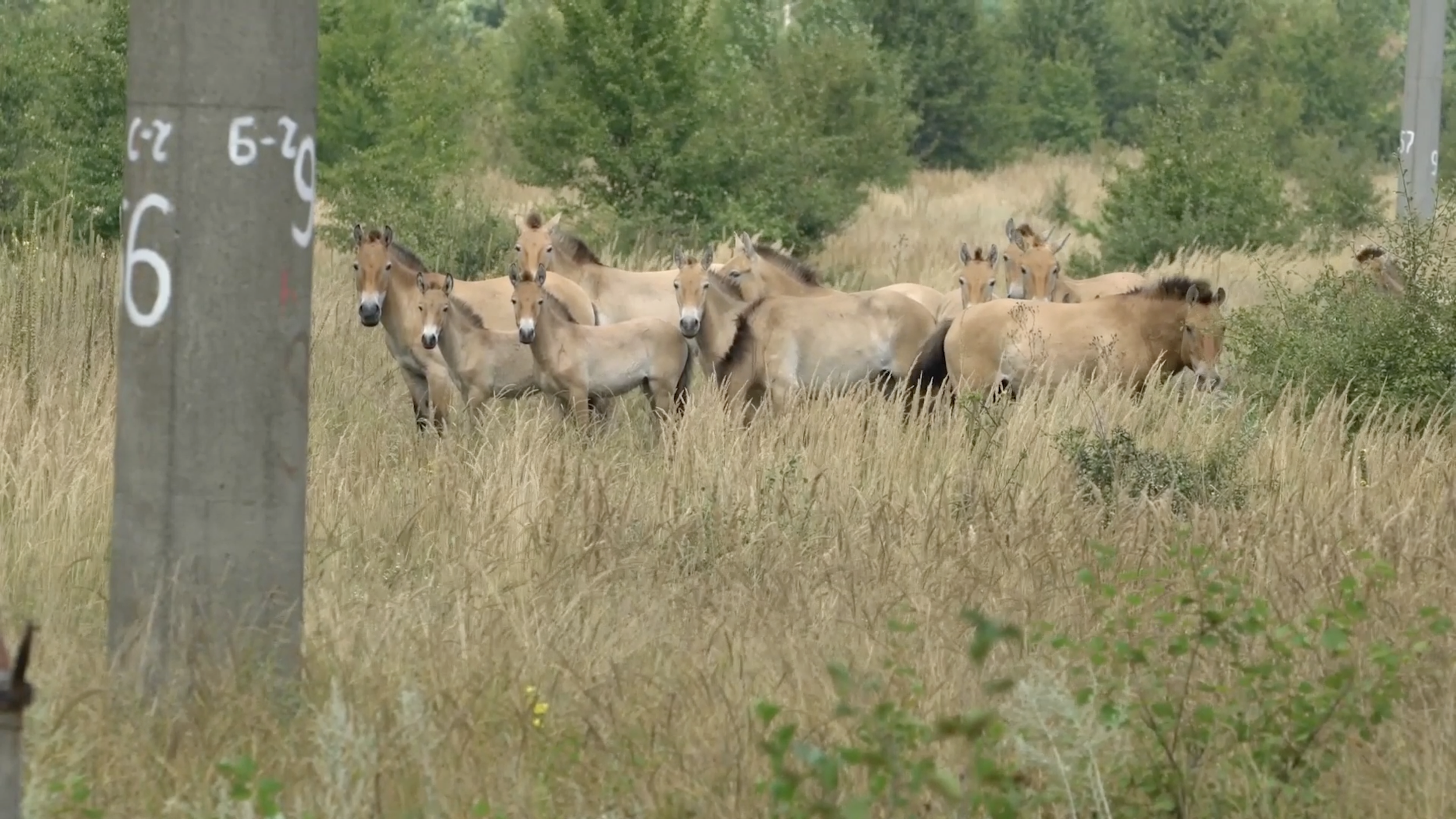
Opening Reception for Garage Exchange: Untitled Energy
The MAK Center for Art and Architecture is pleased to present Untitled Energy, the 25th iteration of Garage Exchange Vienna—Los Angeles, featuring new work by Vienna-based artist Anna Jermolaewa and Los Angeles-based artist Sophie Friedman-Pappas at the Mackey Apartments Garage Top.

Opening Reception for Reading Room
The MAK Center for Architecture is pleased to present Reading Room, an exhibition that reinhabits Schindler’s Kings Road House with practices of reading, featuring publications, artists’ books and printed matter from LA-based practitioners exploring the intersections of art and design. The exhibition features commissioned furniture for reading by Ryan Preciado which surface the often-overlooked stories of skilled artisans who contributed to shaping the built environment, revealing hidden narratives within traditional architectural archives.
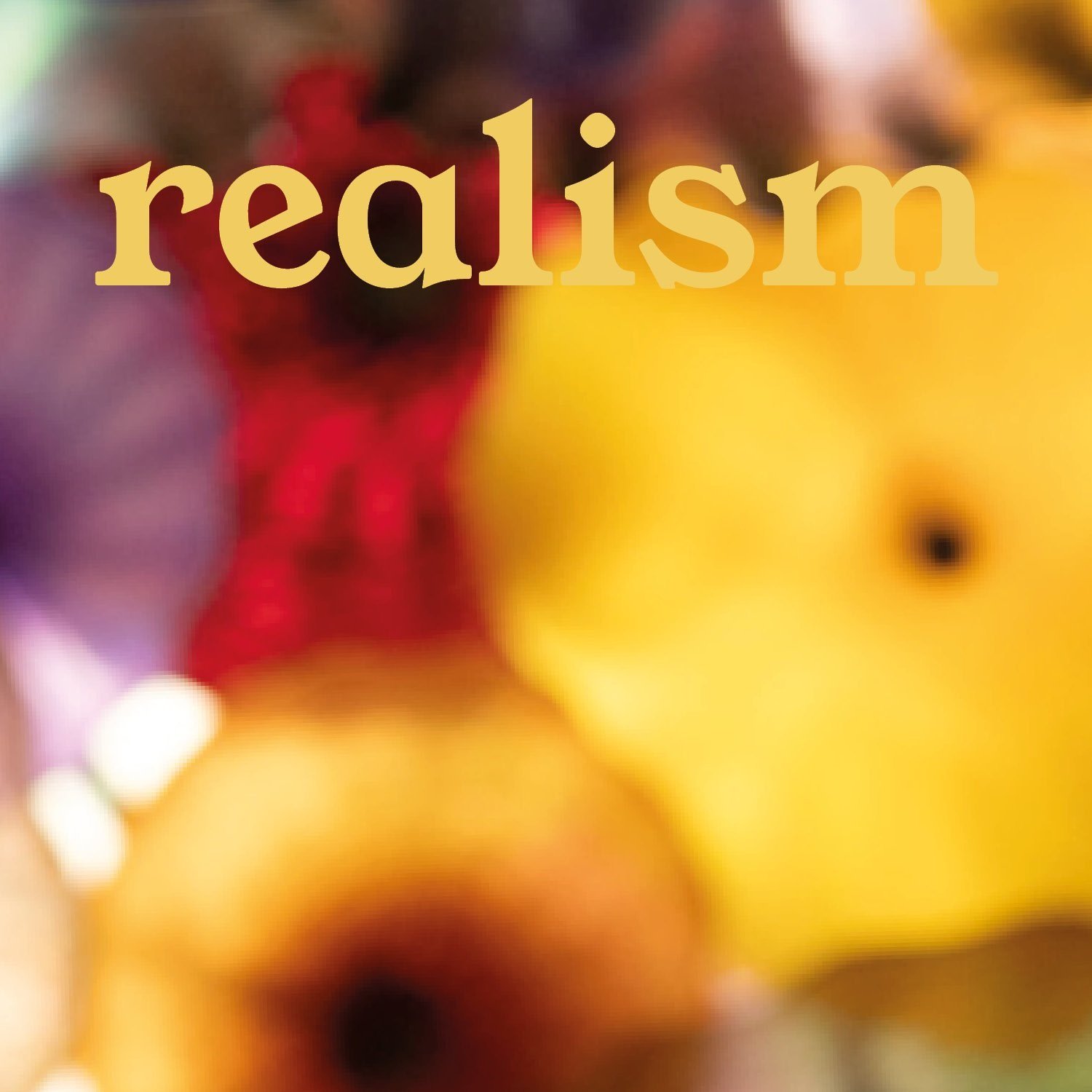
Opening Reception for Final Projects: Group LVI - Realism
Image Credit: Artor Jesus Inkerö, Ursula Mayer, and Paula Strunden.
Join us for the opening reception of Final Projects: Group LVI, exhibiting bodies of work produced by our Artists and Architects-in-Residence, Artor Jesus Inkerö, Ursula Mayer, and Paula Strunden. Final Projects: Group LVI marks the culmination of the 56th iteration of the Artists and Architects-in-Residence Program at the Mackey Apartments.
The Artists & Architects-in-Residence Program at the Mackey Apartments is funded by the Federal Ministry for Arts, Culture, the Civil Service and Sport, in cooperation with the MAK — Museum of Applied Arts, Vienna.
Related Exhibition
Final Projects: Group lvI
February 27, 2025 — March 2, 2025

Opening Reception for Helmut Lang: What remains behind
MAK Center for Art and Architecture is pleased to present What remains behind by Helmut Lang in the artist's first solo institutional exhibition in Los Angeles at the Schindler House.

Opening Reception for Half-Life
Image: Katrin Hornek, testing grounds, production shot, Secession, 2024. Photo: Sophie Pölzl.
Join us for the opening reception of Half-Life, the 24th iteration of Garage Exchange Vienna—Los Angeles featuring works by Katrin Hornek and Brody Albert at the Mackey Apartments Garage Top Gallery.
Katrin Hornek
Katrin Hornek (1983) lives and works in Vienna. She studied Performative Art and Sculpture at the Academy of Fine Arts Vienna and the Royal Danish Academy of Fine Arts. Her work playfully engages with the strange paradoxes and convergences of living in the age of the geologic Anthropocene, where the effects of capitalism, colonialism, and extractivism are written into the body of the earth. Both her artistic and her curatorial practice assert an understanding of the entwinement of nature and culture, implicitly arguing for more complex formulations – most recently, at secession, Vienna (2024), ar/ger Kunst, Bolzano (2021), Kunstraum Lakeside, Klagenfurt (2021), the Riga Biennale (2020), Hysterical Mining at Kunsthalle Wien (2019), and I: project space, Beijing (2018).
She teaches at the University of Applied Arts Vienna (Department of Site-Specific Art) and is a member of the interdisciplinary research group The Anthropocene Commons. She was awarded the Msgr. Otto Mauer Award (2021), the Studioprogram of the Federal Ministry for Arts (2020-2026), the Austrian State Scholarship for visual arts (2017) and the Theodor Körner Award (2013).
BRODY ALBERT
Brody Albert lives and works in Los Angeles. He holds an MFA from University of California, Irvine (2016), and a BFA from Art Center College of Design, Pasadena, CA (2011). Albert is the Associate Professor of Sculpture at Chaffey College and the co-director of the experimental publishing imprint, OHPAPERS. Selected exhibitions include Shapes from The Extramundane with Sara Ellen Fowler, Soldes, Los Angeles (2024), Empty Except for the Ghost, Hunter Shaw Fine Art, Los Angeles (2023); Wavelength, TIMES Museum, Beijing (2022), Built In, Neutra VDL, Los Angeles (2021), We Are All Guests Here, Bridge Projects, Los Angeles (2021); Strata, Pasadena Museum of California Art, Pasadena (2018); Nonlocal, Access Gallery, Vancouver (2018); Exit Strategy with Sara Ellen Fowler, River Gallery, Los Angeles (2017); Solids, Contemporary Art Center, Irvine (2016); Open To The Public, VACANCY, Los Angeles (2016).
This exhibition series is made possible by The Austrian Federal Chancellery with additional support from the Austrian Consulate General Los Angeles.
September 12, 2024 — December 08, 2024
Related Exhibition

Opening Reception for Final Projects: Group LV
Image Credit: Dominic Schwab, Uwe Brunner, Karl Holmqvist, Michèle Pagel, and Kris Lemsalu.
The MAK Center for Art and Architecture is pleased to announce Final Projects: Group LV, exhibiting bodies of work produced by our Artists and Architects-in-Residence, Uwe Brunner, Dominic Schwab, Karl Holmqvist, Michèle Pagel, and Kris Lemsalu. Final Projects: Group LV marks the culmination of the 55th iteration of the Artists and Architects-in-Residence Program at the Mackey Apartments.
The opening reception will feature three performances by our residents:
6:00pm - Uwe Brunner and Dominic Schwab - Vapors Launch
6:30pm - Karl Holmqvist - OCEAN’S 24/7ELEVEN Reading and Book Launch
7:00pm - Mariela Gutierrez SITES performance as part of Michèle Pagel’s Cassette-Label “RatRights”
The Artists & Architects-in-Residence Program at the Mackey Apartments is funded by the Federal Ministry for Arts, Culture, the Civil Service and Sport, in cooperation with the MAK — Museum of Applied Arts, Vienna, with additional support from the Austrian Consulate General Los Angeles.
Final Projects: Group lv
August 29, 2024 — September 02, 2024
Related Exhibition

Entourage Opening Reception and Curator Walkthrough
Join us for the opening reception of Entourage.

Opening Reception for Kathi Hofer and Preserve Bottle Village Committee
Photo: Seymour Rosen, 1972. ©SPACES Archives–Saving and Preserving Arts and Cultural Environments
Join us for the opening reception of Kathi Hofer and Preserving Bottle Village Committee . This exhibition brings together original bottles from Tressa “Grandma” Prisbrey’s collapsed Bottle Village structures, Prisbrey’s assemblage artwork, and works by Hofer placing them in a “magic circle” at the Mackey Apartment Garage Top Gallery where the objects and artifacts relate and resemble one another (ex)changing their value and meaning.
KATHI HOFER
Kathi Hofer (b. 1981, Hallein, Austria) works conceptually across media. She is interested in forms of everyday creativity and their specific freedoms and constraints as well as in the relationship between artistic work and socio-economics. In her installations she integrates found objects, images, stories, and practices that have strongly determined the roles and values within the environments she grew up in or moves within today. In addition to her installation-based work, she has recently turned to immaterial practices and experimental forms of storytelling. In this context, she has initiated improvised encounters between actors from different cultural fields or backgrounds in public or semi-private space staging unannounced performances that took place in the absence of an audience. Of these unrehearsed, unnoticed actions photographic evidence remains that is open for further interpretation. Recent exhibitions include Continental Baths (London, UK), the MAK Center for Art and Architecture (Los Angeles, US), Winona (Brussels, Belgium), Tokyo Arts and Space (Tokyo, Japan), Austrian Cultural Forum (Warsaw, Poland), MAK – Austrian Museum of Applied Arts (Vienna, Austria), and mumok – Museum moderner Kunst Stiftung Ludwig Wien (Vienna, Austria). Her book “Grandma” Prisbrey’s Bottle Village was published by Spector Books, Leipzig (2021).
PRESERVING BOTTLE VILLAGE COMMITTEE
Preserve Bottle Village Committee is a non-profit organization formed in July 1979 to acquire and restore the privately-owned historic property. In the intervening decades, dedicated members have been responsible for ensuring the protection of Bottle Village. The long-term objective of the organization is to allow public access on a regular basis to the fully improved and restored Bottle Village. In 2012, the organization initiated a comprehensive restoration approach for the entire one-third acre site and its historic components. For the Garage Exchange exhibition, Preserve Bottle Village Committee board member Katherine Weisman collaborated closely with Kathi Hofer, the MAK Center, and RLA retrieving and selecting artifacts.
This exhibition series is made possible by The Austrian Federal Chancellery.
KATHI HOFER AND PRESERVING BOTTLE VILLAGE COMMITTEE
April 18, 2024 — June 16, 2024
Related Exhibition

Opening Reception for Final Projects: Group LIV
The MAK Center for Art and Architecture is pleased to announce Final Projects: Group LIV, exhibiting three works produced by our Artists and Architects-in-Residence, Anna-Sophie Berger, Bianca Gamser, and Evan Ifekoya.

VALIE EXPORT: Embodied Opening Reception
The MAK Center for Art and Architecture is pleased to present VALIE EXPORT. A monumental figure working with feminist actions since the 1960s, VALIE EXPORT’s work has redefined the field of performance, expanded cinema, and artistic practice.

Print Ready Drawings Opening Reception
Celebrate the opening of Print Ready Drawings at the Schindler House.

and yet you grow Opening Reception
The MAK Center for Art and Architecture is pleased to present the 22nd iteration of Garage Exchange Vienna—Los Angeles: and yet you grow featuring work by Vienna-based artist Christian Kosmas Mayer and Los Angeles-based artist Gala Porras-Kim at the Mackey Apartments Garage Top Gallery.

Opening Reception for Final Projects: Group LIII
The MAK Center for Art and Architecture is pleased to announce Final Projects: Group LIII, exhibiting three works produced by our Artists and Architects-in-Residence, Simona Ferrari, Céline Brunko, and Philipp Fleischmann. Final Projects: Group LIII marks the culmination of the 53rd iteration of the Artists and Architects-in-Residence Program at the Mackey Apartments.

Opening Reception for Garage Exchange Vienna—Los Angeles: Plastic, Plastic, Plastic
Image: Courtesy of the artists
The MAK Center for Art and Architecture is pleased to present the 21st iteration of Garage Exchange Vienna—Los Angeles: Plastic, Plastic, Plastic featuring new work by Vienna-based artist Kerstin von Gabain and Los Angeles-based artist Ellen Schafer at the Mackey Apartments Garage Top Gallery. The artists confront the legacy of Modernist idealism that Schindler considers in his architectural work alongside the proliferation of mass-produced materials.
Plastic, Plastic, Plastic
Text by Angella d’Avignon
“The German poet and playwright Bertolt Brecht hated the Westside. He hated Hollywood, the only part of Los Angeles he seemed to be familiar with. When he arrived in 1941, Santa Monica was flat while he lived there—nothing but manicured lawns and oil derricks in dust fields.
The Mackey Apartments are replicated* at Disney World in Florida to signify a modern California apartment—the platonic ideal of apartments, landmarked as classic Los Angeles architecture although they were built in the last eighty or so years. The idea that California held the dream of the mythic West itself in its "empty" landscape, that acreage could ensure legacy, that private property meant success. These precious places built by eccentrics and exiles, polished apartments made for one specific person, sit empty most of the time, while renters drift in and out of sublets and single family studios. These interiors hold other people's boring day to day existences, hovering together anachronistic in the psychic space of a room.
In Los Angeles, you can tell the time of the month by the amount of furniture on the sidewalk—entire sofa sets, wayward mattresses, coffee tables and glass cabinets. Recognizable objects from one's interior is a kind of body horror—I once spotted a stack of metallic plastic cups I'd bought for my first apartment in my twenties from a store I thought was expensive. No one else had party cups like mine at the time, yet here they are on someone else's stairs, outside someone else's apartment that looks replicable, like it could be anywhere in suburban Southern California.
The word polymer means ‘of many parts,’ and polymers are made of long chains of molecules. Polymers abound in nature. Cellulose, the material that makes up the cell walls of plants, is a common natural polymer. Synthetic polymers are made up of long chains of atoms, arranged in repeating units, often much longer than natural ones. The length of these chains, and the patterns in which they are arrayed, make polymers strong, lightweight, and flexible. In other words, it’s what makes them so plastic.
Plastic ensured that human manufacturing would never be limited by the resources offered by the natural world. Roland Barthes called plastic ‘miraculous,’ writing that ‘plastic is the very idea of its infinite transformation,’ since any substance—ivory, tortoiseshell, glass—could be made from plastic. Barthes continues, ‘The hierarchy of substances is abolished: a single one replaces them all: the whole world can be plasticized, and even life itself since, we are told, they are beginning to make plastic aortas.’ The 21st century world is saran wrapped: by 2050, the ocean will be more plastic than water.
While plastic wooed the mid-century U.S, long-chains of houses proliferated across Brecht's hellish flat fields, entire neighborhoods sprouting up like manicured weeds, filling with mass manufactured domestic housewares made in consumer-grade plastic, taunting the poet's former presence in Los Angeles, after he fled again for his native Germany after 15 years of exile in the U.S. during World War II. Layers of layers of daily life held forth in these houses and apartments, each one haunting the next generation while the plastic utensils, hair combs, high chairs, bed pans, and party cups outlive every vision of utopia that anyone's had about Los Angeles since.
The narrative of transience is scaled by class. The burdens of precarity and desire meet in the well-appointed interiors whose objects' total value will never outweigh the endlessly unaffordable exterior in which they're housed. We are not the objects we consume but rather the paths we tread through spaces anonymous to anyone who treads them in our absence.”
*While the Prime Time Cafe at Disney World’s Hollywood Studios is not an exact replica of the Mackey Apartments, the Imagineers used it as inspiration to construct a general set of modern California apartments representing idealized mid-century living.
This exhibition series is made possible by The Austrian Federal Chancellery.
Related Exhibition
Thurs, June 8, 2023
6:30—8:30 pm

Opening Reception for Seeking Zohn
The MAK Center for Art and Architecture is pleased to present Seeking Zohn, an exhibition of works by Mexican-Austrian architect and engineer Alejandro Zohn (1930-2000) through contemporary photography and design. The exhibition takes as subject Zohn’s robust civic and commercial architecture built in Guadalajara from the 1950s to the 1990s, with an interest in how the city’s social, cultural, and material histories are interwoven with his structures.
Commissioned photography and video by artists Adam Wiseman, Lake Verea, Onnis Luque, Sonia Madrigal, and Zara Pfeifer veer from the documentary conceit of architectural photography toward the subjective. This work is decidedly interpretive, seeking out the many narratives contained within parks, markets, collective housing, malls, and bureaucratic buildings. Zohn, a Jewish emigree who fled Vienna during World War II at the age of 8, dedicated his career to creating a modern Guadalajara. Through these photographs—acts of investigation and translation—we find glimpses of his utopian desire amidst the chaos, beauty, and violence of everyday life.
Seeking Zohn is the first presentation of Zohn’s architecture in Los Angeles. The transposition of his work to L.A. places it in dialogue with R.M. Schindler’s designs. As both architects are Jewish émigrés, a parallel exists between the Austrian-Mexican and the Austrian-Angeleno’s experiences. The installation at the MAK Center creates a resonant triangulation between three cities: Vienna, Guadalajara, and Los Angeles. Billboards placed in the garden navigate between the urban scale of Zohn’s buildings and the intimacy of the Schindler House. Household objects designed by Studio Fabien Cappello and fabricated by artisans in Guadalajara build a bridge between the civic and domestic realms.
Seeking Zohn is made possible, in part, with generous support from the City of West Hollywood, the Graham Foundation for Advanced Studies in the Fine Arts, the Pasadena Art Alliance, the Los Angeles City Department of Cultural Affairs, Ago Projects, the Austrian Consulate General Los Angeles, Plant Material, and University of East London Production Support.
Above Image: Alejandro Olávarri, 2023
Thank you to our beverage sponsor Tequila Tepozán .
Related
Exhibition
SEEKING ZOHN
April 01, 2023 – July 23, 2023
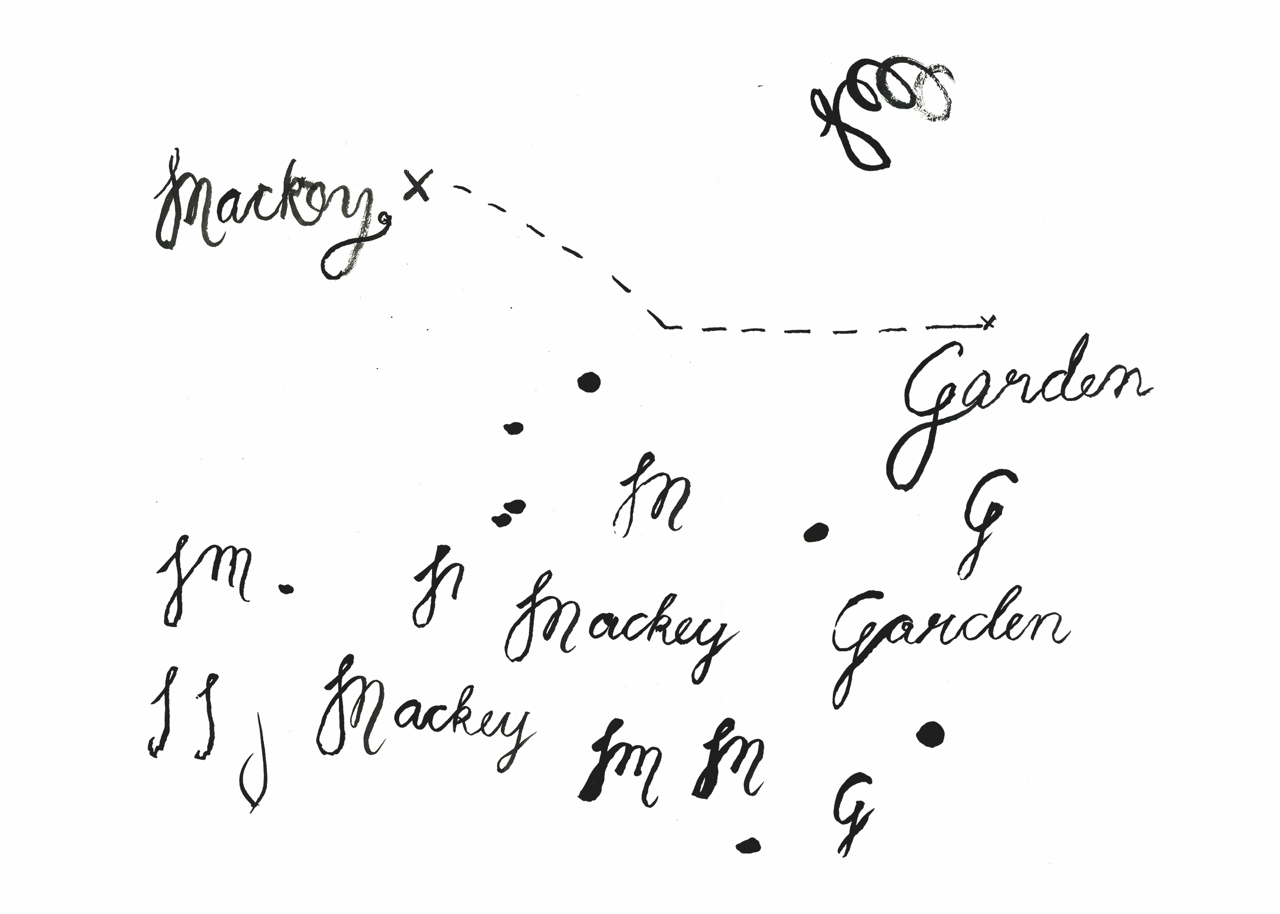
Opening Reception for Final Projects: Group LII
The MAK Center for Art and Architecture is pleased to announce Final Projects: Group LII, exhibiting three works produced by our Artists and Architects-in-Residence, Cathleen Schuster, Marcel Dickhage, Louise Morin, & Melanie Ebenhoch. Final Projects: Group LII marks the culmination of the 52nd iteration of the Artists and Architects-in-Residence Program at the Mackey Apartments.
For the Saturday presentation of Louise Morin’s work, please visit The Garden, 1911 7th Avenue, Los Angeles, CA 90018, on Saturday, March 11, 2023, from 1:00 PM - 5:00 PM. This is a free event, no RSVP required. Morin’s work will also be on view at the Mackey Apartments Garage Top for the duration of the exhibition.
Read more about our residency program here.
The Artists & Architects-in-Residence Program at the Mackey Apartments is funded by the Federal Ministry for Arts, Culture, the Civil Service and Sport, in cooperation with the MAK — Museum of Applied Arts, Vienna.
Image Credit: Melanie Ebenhoch, 2023
Related
Exhibition
FINAL PROJECTS: GROUP LII
March 10, 2023 – March 12, 2023

Opening Reception for Alex Katz: Sunrise
Join the MAK Center for Art and Architecture, Schindler House, for the opening reception Alex Katz: Sunrise. The exhibition is the latest iteration by the 95-year-old artist’s ongoing series he refers to as ‘splits’. Using a cut-up technique he blends inspiration from Manet’s pictures of women in hats in the sun, the fractured imagery from early cubism as well as the ‘cheap’ quality in Fassbinder’s ‘Beware of a Holy Whore,’ these large-scale immersive portraits of Sunrise Ruffalo encapsulate the fleeting nature of the gaze inside everyday life.
This event is free and open to the public. No RSVP required. Refreshments will be served.
This exhibition is presented with support from Gladstone Gallery.
Above Image: Alex Katz , Sunrise 12, 2021. Oil on linen, 96 x 72 inches (243.8 x 182.9 cm). © Alex Katz / VAGA at Artists Rights Society (ARS), NY Courtesy of the artist and Gladstone Gallery.
Related
Exhibition
Alex katz: sunrise
Thursday, February 16 - Sunday, March 12, 2023

Opening Reception Vienna — Los Angeles Garage Exchange: Maruša Sagadin & Jacqueline Kiyomi Gork
The MAK Center is pleased to present the twentieth iteration of Vienna — Los Angeles Garage Exchange: Maruša Sagadin & Jacqueline Kiyomi Gork. Vienna-based artist Maruša Sagadin collaborates with Los Angeles artist Jacqueline Kiyomi Gork. The artists respond to each other’s work to develop an exhibition for the Mackey Apartments’ Garage Top Gallery.
This is a free public event. No RSVP required.
This exhibition series is made possible by The Austrian Federal Chancellery.
Header image: Courtesy of the artists, Jacqueline Kiyomi Gork, Empty Gallery HK, and Maruša Sagadin Christine König Galerie, Vienna, 2022.
Photography: Gabriel Bruce, 2022.
Related
Exhibition
Vienna — Los Angeles Garage Exchange:
Maruša Sagadin & Jacqueline Kiyomi Gork
Thursday, November 10, 2022 – Sunday, January 29, 2023

Final Projects: Group LI Opening Reception & Mackey Apartments Open House
The MAK Center for Art and Architecture is pleased to announce Final Projects: Group LI, exhibiting two installations produced by our Artists and Architects-in-Residence, Kamilla Bischof and Robin Durand. The residents open their respective apartment units to exhibit two unique final project installations, Kamilla Bischof: Princess Bone, and Robin Durand: A Traverse of L.A. Select installation elements stretch out to the Garage Top outdoor courtyard.
Kick off your Labor Day weekend with music, hot dogs, and contemporary art and architecture at the Opening Reception for Final Projects: Group LI, Thursday, September 1st, starting at 6:00 PM. Complemented with an Open House of select Mackey Apartment units. This is a free public event. No RSVP required.
The Artists & Architects-in-Residence Program at the Mackey Apartments is funded by the Federal Ministry for Arts, Culture, the Civil Service and Sport, in cooperation with the MAK — Museum of Applied Arts, Vienna.
Image Credit: Betül Seyma Küpeli
Related
Exhibition
FINAL PROJECTS: GROUP LI
September 01, 2022 – September 04, 2022


